





West Parley West Parley

Both Centres are open as usual on Bank Holidays. West Parley closed Easter Sunday








Both Centres are open as usual on Bank Holidays. West Parley closed Easter Sunday
Canford School’s fine arboretum opens for the National Garden Scheme on Saturday 19th October, with a talk and guided tour given by the school’s master of trees.
The arboretum at Canford School has been nationally recognised, with several unusual and rare tree species and two national collections.
Dr Andrew Powell, Master of Trees at Canford School will share his wealth of botanical knowledge and talk about the history and ongoing developments at the arboretum, a very entertaining morning amongst this majestic collection of trees.
The trees range from native species to those from the Americas and Asiana, deciduous and evergreen trees, hybrid trees, champion trees, and plantings with heights ranging from over 135 foot to five feet. Various trees have been a central character in events from the days of the owners of the original manor house to the present-day school, and guests will hear informative and amusing historical stories involving these trees.
The morning runs from 10am until 1pm, with light refreshments available. Pre-booking is essential, tickets £25. www.ngs.org,uk
“I cannot endure to waste anything as precious as autumn sunshine by staying in the house. So, I spend almost all the daylight hours in the open air”
- Nathaniel Hawthorne
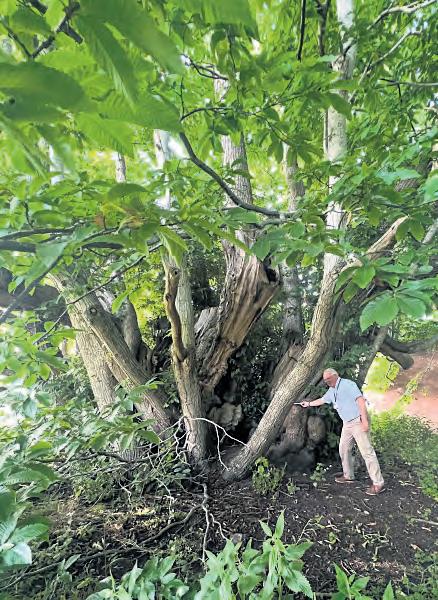
Canford School Arboretum, Canford Magna, Wimborne, Dorset BH21 3AD

Fergus Garrett of Great Dixter will reveal how vital biodiversity can thrive in anybody’s cultivated garden patch, using evidence gathered from the world-famous garden that he looks after. He will give his lecture ‘Gardening for the Future’ on Tuesday, 26th November at 7pm at London’s Garden Museum in Lambeth Palace Rd, SE17LB.
Great Dixter is one of Britain’s most famous gardens, revered and admired for balancing its heritage with being in the vanguard of gardening trends and looking to the future. As we all begin to realise the dramatic impact our garden environments can have on reversing the decline in our nation’s biodiversity, close study of the various areas at Great Dixter have produced fascinating evidence. Fergus, Chief Executive of the Great Dixter Charitable Trust – but also a very hands-on head gardener – will reveal the exciting picture that was discovered and talk about the positive implications for all gardeners. All proceeds will go to the National Garden Scheme. You can watch the live-stream online at www.gardenmuseum.org.uk
Westlands Farm Shop has submitted plans to Winchester City Council to transform a closed cafe on the busy high street into a farm shop, bringing fresh and locally sourced produce to the heart of the city.
The planning application details thorough renovation to both the interior and exterior of the building - previously ‘Patisserie Valerie’ - which has been closed since New Year’s Day.
Graham Collett, owner of Westlands Farm Shop, said: “Our decision to expand into Winchester is driven by the overwhelming support and demand we’ve received from our customers in Wickham.
“We’ve seen a growing interest in high-quality, locally sourced food, and we believe the people of Winchester will appreciate the freshness and authenticity that Westlands Farm Shop brings.
“Our plans are in their infancy at the moment, but we hope to be open in November - well in time for the Christmas rush of people looking for the freshest locally-sourced meats and foods for their Christmas.”
Known for its commitment to sustainable, local farming, Westlands Farm Shop will continue to champion Hampshire’s agricultural heritage in its new store, offering customers an authentic farmto-table shopping experience.
Carey’s Secret Garden in Wareham is doing more to help stressed mums - and dads! The popular Dorset gardens are staging special parent and toddler groups through to the end of October where the idea is to provide a beautiful, tranquil space where connecting to nature is the name of the game. Sessions run from 9.30am to 11am and visitors can stay in the garden as long as they like after the session.
Carey’s Secret Garden, Garden Wood, Wareham BH20 7PG
Nearly 12,000 enraged homeowners have made an official complaint about the dire state of their neighbour’s garden over the last year. The findings come after local services marketplace specialists, Airtasker, carried out a three-month investigation into one of the most common causes of arguments across neighbourhoods in Britain, disputes.
By submitting Freedom of Information (FOI) requests to every local authority across the UK, the investigation was able to paint a very specific picture of the nation’s garden gripes.
In the south-west the biggest reason for official complaints was defined as overgrown gardens spreading over boundaries. The other main issues were:
Pruning overhanging trees/bushes - You are allowed to prune branches that overhang into your property up to the boundary line. However, always let your neighbour know first, as improper pruning leading to damage could result in a costly property damage claim.
Light being blocked by high hedges and bushes - A neighbour’s high hedge or shed blocking light can lead to disputes due to the ‘right to light,’ which entitles a person to a certain amount of natural light. Ignoring this right may result in legal action or compensation claims.
Invasive plants and weeds - If invasive plants like Japanese knotweed are in your garden, take immediate steps to prevent them from spreading, as this can be a criminal offence. Seek professional advice for removal and consult a dispute lawyer if needed, as landowners may seek an injunction or compensation for damages.


The elegant, expansive garden at EDMONDSHAM HOUSE, Edmondsham, Wimborne, Dorset BH21 5RE opens for the National Garden Scheme on Wednesday afternoons during October. There are six acres of mature gardens and grounds to explore, with trees, rare shrubs and shaped hedges surrounding the historic house, and the 12th century church adjacent to the garden. The large Victorian walled garden is productive and managed organically, using ‘no dig’ vegetable beds, wide herbaceous borders are planted for seasonal colour, there’s a traditional potting shed, cob wall and sunken greenhouse.
Opening on Wednesdays 2nd/9th/16th and 23rd, from 2pm until 5pm, admission is £4, with £1 for children. Hot and cold drinks and cake are available, plants for sale, there’s wheelchair access and coaches are welcome by appointment. Dogs not allowed. For contact details go to www. ngs.org.uk and follow the links.


There’s the opportunity to view a stunning collection of sparkling nerine sarniensis or ‘Jewel Lilies’ throughout October at Exbury Gardens.
Originally found on Table Mountain overlooking Cape Town in South Africa, jewel lilies flower in a spectrum of colours from their original oranges, scarlet and white through new purples, pinks, mauves, reds, scarlets, copper and bronzes. They scintillate in the sunshine with gold or silver crystalline flecks that make their petals sparkle.
Exbury director, Nicholas de Rothschild has produced over 100 new hybrids, and welcomes visitors to view these stunning plants in this exclusive exhibition. Nerines will also be available to purchase. The exhibition will be in the Five Arrows Gallery and runs through to 3rd November. Free with gardens admission or Friends of Exbury membership.
Exbury Gardens & Steam Railway, Summer Lane, Exbury, Southampton
On Sunday 13th October
FRANKHAM FARM, Ryme Intrinseca, Sherborne, Dorset, DT9 6JT opens for the National Garden Scheme. The three and half acre garden, created since 1960 by the late Jo Earle for yearround interest is filled with a wide variety of well grown plants, roses, unusual, labelled shrubs and trees, a productive vegetable garden and much autumn colour, particularly the oaks.
Open from 12pm until 5pm, admission £7, children free. Refreshments available in the newly converted barn, including barbecue using meat from the farm; wheelchair access, coaches welcome, dogs not allowed. This is a venue offering accommodation - for contact details go to www.ngs.org.uk and follow the links.



Since 1926, CPRE has campaigned for a countryside that is rich in nature, accessible for all and protected for the future.
Its proud history includes advocating for rural spaces, National Parks and the Green Belt, as well as ensuring local people have a say on what gets built where they live. Some of CPRE’s recent successes include securing commitments to restore hedgerows and influencing the government’s planning reforms.
Yet the countryside remains under threat now more than ever. CPRE has partnered with Farewill to offer the opportunity to write your will for free. After providing for your loved ones, you can consider leaving a gift in your will to CPRE to let your love of the countryside live on.
For more information on leaving a gift in your will to CPRE, contact legacyinfo@cpre.org.uk
If you think your garden can be developed or improved to help the local community then a garden grants programme has just opened for this year. The National Garden Scheme will look at applications for its Community Garden Grants programme through to Monday 28th October.
These hugely popular grants provide funding to amateur gardeners from community groups to create or complete a garden or similar project (such as an allotment) that has a horticultural focus for the benefit of the local community or charitable group. The aim should be to bring a community together by creating or developing a space that people can share, by the acquisition and sharing of gardening knowledge and skills, and by inspiring a love of gardening.
In 2024, 89 community garden projects were funded with grants totalling £232,000 supporting community gardens and allotments, rehabilitation and regeneration projects, gardens designed to support mental health and wellbeing, as well as training and development for young people.
For more details and an application form visit: https://ngs.org.uk/who-we-are/communitygarden-grants/
Athelhampton House and Gardens will be the venue for a new event when a host of Dorset producers, growers and makers sell their produce on Athelhampton’s West lawn on Saturday, 19th October from 10am to 3pm.
The market is free and is open to allow everyone the chance to purchase the finest products the county has to offer.
The popular house and gardens will be open as well (normal admission charges apply).
It’s the perfect opportunity to shop for a wide selection of products and artisan crafts.
Athelhampton House & Gardens, Athelhampton, Puddletown, Dorchester DT2 7LG
Jane Austen lovers can join in the celebrations of the anniversary of the publication of Mansfield Park on Friday, 11th October when there’s a special lecture and walking event at the popular author’s house.
The event begins with a talk about Jane Austen and her family’s connections to the British Empire before setting out on a three kilometre walk in the field and woods around Chawton.
The event includes house entry and costs £16.50. From 11am to 12.45pm. Jane Austen’s House, Winchester Road, Chawton Hampshire GU34 1SD

Cleaning up fallen leaves is the burden of many a gardener.
If there is a simple message however when it comes to leaves then it probably is –‘Leaves are not litter – they are a wonderful garden free resource’.
In October and certainly into November gathering the leaves can be a chore - good exercise but still a chore!
Just as you have finished, the leaves start to fall again! It can feel like trying to hold back the tide. Just remember the incredible leaf mould compost which you can produce from fallen leaves will enrich your garden?
No gardener likes cleaning up leaves but come the autumn months it is something that most gardeners need to tolerate. Leaf mould compost is an excellent way to rid yourself of wet slimy leaves and enrich your garden with nutrient-rich leaf mould compost.
It costs virtually nothing and if you don’t mind waiting around 12 months, then you have a perfect compost to mulch your garden with.
Making your own leaf mould is highly beneficial for gardeners.
Leaves can be put formally into a wire mesh bin, a more formal wooden, fenced area or in fact just left in a pile in a corner of the garden.
The mould it finally produces provides a sustainable and environmentally friendly way to recycle organic waste, reducing the need for chemical fertilisers and landfill contributions.
Secondly, leaf mould enhances soil structure by improving its texture, water retention, and aeration, creating an optimal environment for plant growth.
Additionally, it adds valuable organic matter to the soil, enriching it with essential nutrients and beneficial microorganisms. Moreover, leaf mould helps suppress weeds, regulates soil temperature, and prevents erosion, contributing to overall garden health and resilience. Furthermore, producing leaf mould is cost-effective and easy, requiring minimal effort and resources. Overall, making your own leaf mould is a valuable practice that promotes soil health, sustainability, and garden vitality. For best results turning your fallen leaves into mulch,shred the leaves before winter. Shredding can be
as simple as chopping the leaves up with a lawnmower or using tools created specifically for this process. While shredding is not necessary, it will lead to a more consistent mulch that is darker in colour.
Some leaves are harder to compost than others because they take longer to break down. Examples are holly, cedar, pine, and oak.
If you have a spare compost bin, you can use it to store leaves to make leaf mould. However, you shouldn’t use the same bin for regular compost waste because the leaves will sit undisturbed for at least a year.
There is a far easier way which involves using bin liners or bags to make leaf mould, especially if you are new to leaf mould. This takes about half the time of the traditional method and guarantees you amazing leaf mould compost in about 12 months.
It’s also great for those with space restrictions and those who can’t build permanent compost bins. It allows you to make leaf mould and experience its benefits before committing to building custom permanent leaf mould compost bins.
There are one or two tricks to speed things up a little. Leaves contain high levels of carbon and small amounts of nitrogen. The microbes that decompose leaves and other types of organic matter require nitrogen for their own metabolism and growth. A compost pile composed mainly of leaves decomposes slowly because the leaves don’t contain adequate levels of nitrogen for the microbes. To promote decomposition, mix leaves with grass clippings or other materials high in nitrogen. If possible, shred the leaves prior to composting. The smaller the size of the material, the faster it will decompose.
Construct the compost pile in layers. Each six inch -layer of plant material should be topped with one inch of soil or compost. A small amount of an all-purpose garden fertiliser can also be added to supply nitrogen to the microbes. Continue to build the compost pile in layers until it is three to five feet high.
Finally, water the pile regularly and turn it about once every two weeks.
If you’ve recently had landscaping done or ordered any materials from a builder’s yard, the chances are you will have a couple of those huge plastic woven sacks lying around. Rather than sending them to landfills, use them to make amazing leaf mould.
Simply stuff them full of leaves, use the corner loops to tie them up and then leave somewhere out of the way for 12-18 months whilst they break down. They don’t need draining holes as they already let water and air pass through them.

When leaf mould is ready for use, it should be a dark rich brown colour. Slightly moist and crumbly. This is when it is at its prime. It may have already lost most of its good stuff if it is dry and dusty. If it still looks like wet leaves, then it needs longer!
Leaf mould has many uses in the organic garden or for growing your own plants or vegetables.
• Leaf mould is an excellent mulch that can help improve your soil condition and protect plants from water stress during periods of high temperatures during the summer months.
• Leaf mould is incredible for seedlings and propagating plants. As it has such a fine crumb structure, it’s great for seedlings to root in and is super free draining.
• If you need to help break up compacted soil then leaf mould is really useful in adding air and improving soil texture.
• Use leaf mould as a top dressing for a lawn to add a slow-release feed in autumn or spring.

CPRE,








residents have taken it in turns each day to tend to the sunflowers and ensure they stay slug and pest-free.
The residents have also been enjoying trips out to their local garden centre to gather inspiration for bulbs and plants to grow in the garden ready for spring next year.
At this time of year, the residents are planting bulbs in pots and working together to bring additional colour into the care home garden. They always look forward to seeing what takes off in the spring.
Gardening can provide a host of therapeutic benefits for everyone but it’s particularly beneficial as we get older. These include:
• Boosting emotional wellbeing – Gardening offers a calming connection with nature providing an opportunity to enjoy some peace and quiet in the great outdoors as we watch the leaves change colour
• Physical exercise – Activities like planting bulbs and pruning leaves offers gentle exercise to promote flexibility, strength and balance, offering overall mobility
• Sensory engagement – The range of autumn colours, textures and scents can stimulate the senses and can often trigger happy memories of gardening with family members
• Social interaction – The joy of gardening is universal. It’s something that many people enjoy so it’s a great way to bring people together to chat and share tips on growing bulbs and plants
Fern Brook Lodge, which is run by the not-for-profit charity Care South, provides specialist residential, respite,
and dementia care. The care home features a range of communal lounges overlooking a landscaped garden for residents to enjoy, with The Brook serving as an additional communal area for the residents to host activities and events. Fern Brook Lodge has a dedicated activities team who organise a daily programme of events to bring residents together to socialise and build friendships.
Care South is a leading provider of high quality residential and home care services across the south of England. The not-for-profit organisation, which is a registered charity, has care homes in Dorset, north Devon, Somerset and West Sussex, and home care offices covering east and west Dorset, and northeast Somerset and south Somerset.







Saving your seeds whether it be flowers or vegetables is the best way to propagate your garden – and the cheapest. It’s also a way of saving our heritage plants.


Collecting seeds from your own garden plants can save you a fortune.
By October many plants have produced seeds that can be collected and stored ready to be sown the following spring. Different types of seeds need to be collected in different ways to ensure you end up with as many as possible, at the right stage of ripeness, before they fall or are blown away on a breeze.
Hold off on deadheading and leave some of your favourite flowers to set seed. Then keep a close watch as the seeds ripen over the coming weeks and months.
The best policy when collecting seeds is to check your plants often, to know when they’re ready to harvest.
Aim to collect seeds on a dry day, when seedheads aren’t dewy or moist. All you need are some sharp secateurs or strong scissors and old envelopes or recycled paper bags. Make sure seeds are thoroughly dry before storing, and avoid plastic bags, as these can encourage damp. Lastly, label the envelopes with the plant name and date of collection.
Different people save seed for different reasons. Some do it to preserve a link with the past, growing a variety their parents grew or one peculiar to the place they live.
Some do it to assure themselves a supply of seed of a variety no longer available. Some are making a deliberate
stand against current trends in the seed industry. Some, like the Heritage Seed Library’s Seed Guardians, do it in order to create surplus seed that can be given to others. Some people are saving seed because they always have done so.
The International Seed Saving Institute suggests these five crops for beginners: beans, lettuce, peas, pepper, and tomato. All these plants produce mature seeds in one season and have flowers that are self-pollinating, so you don’t need a lot of plants and you don’t have to worry about them crossing with other varieties. After the mature seeds are gathered, they can simply be dried, with no special treatment needed before storage.
When you save your own seeds, the difference is striking. They are much fresher and just want to grow, if you observe the basic tenets, such as plant numbers for cross-pollination.
Vegetable breeding in the last three or four decades has concentrated on hybrid varieties, many of which grow excellent vegetables, with high yields and good flavour. Unfortunately, from a seed saver’s perspective, they don’t breed true. For example, do not save seed of hybrid tomato varieties such as Sungold and Rosada F1.
The result is only one generation of a desired outcome and, if you sow seeds from those plants, your new plants have a random mix of less desirable traits.
Seed packets state ‘F1’ if they are hybrids. The results are predictable, consistent and profitable, the reason for seed producers favouring work on F1 hybrids, rather than on open-pollinated strains.
The best seed saving results happen in a dry summer. Stems may need support because they grow tall, and the seedheads are quite heavy when wet. Check for ripeness by rubbing a floret or two, in search of the hard black seeds. Cut off the heads and put them somewhere very dry, until almost crisp, then rub out the seeds by hand, wood or foot.
These are easy to save because seed is mature just one month or so after the normal period of eating them.
From mature peas at their normal picking stage, it takes two to four weeks of summer weather to have dry peas for a seed harvest, and for French beans a little longer. Just one plant of any one variety will give viable seed, true to type.
Wait for seeds to ripen fully on the plant before cutting off the flower spike. Remove in several pieces if it’s as large as this.
Have a paper bag to hand for transporting the flower spike as seeds will quickly fall and be lost if you carry them far.
Gently tip the bag out onto a sheet of paper, making sure you remove all the seeds. Pick out any bugs or pieces of debris.
Funnel the seeds into paper envelopes, not plastic bags. Write full details of the plant on the envelope, including the date.
These grow in the same way as peas, except that the pods turn black when dry and with ripe seeds.
These are easy to save but later to mature than peas and broad beans.
In dry climates these are easy, but if there is too much damp weather as flowers turn to seeds in late summer, the seedheads risk rotting just before harvest. Sow in either early autumn or late winter – lettuce plants survive frost, so autumn sowing works. Small yellow flowers develop in late summer, into tight clusters of ten to fifteen seeds. Once you can separate seeds from the clusters, twist out the whole plant and hang it somewhere dry to finish the seed-drying process.
Remember to only save seed from open-pollinated varieties, not hybrids. Cut the tomato, as if preparing it to eat, and scoop out any seeds. Place the seeds, and any tomato fruit sticking to them, in a cup with some water, and leave in the kitchen to ferment. This breaks down germination inhibitors on the seed. After five to seven days, you will notice a black mould on top of the water, which you can scoop off; the seeds will be at the bottom. Give seeds a rinse and then place, in a dry place for a few days. Then pop into an envelope or an old seed packet, clearly labelled.
Apple days are here again with extravagant, and fun filled apple themed events taking place throughout the Cotswolds and the south-west - at National Trust properties and community orchards and more.
Each year, to celebrate apples and orchards, Apple Days are held all over the country to demonstrate the richness and diversity of apple varieties, orchards, soil ecology and culture.
Apple Day is Monday 21st October, but there are several apple themed events held during the whole month of October, some at National Trust properties, others at country estates and community orchards.
So get your layers of warm clothing and boots on to enjoy the autumn colours and scents at any of these apple events to find out more about our wonderful apple heritage - and perhaps to take some home.

Brockhampton, the moated medieval manor house tucked away in a Herefordshire valley, celebrates the harvest season on Saturday, 5th October from 11am until 3pm. Grab a bag from visitor reception and pick your own apples, take part in an apple pressing demonstration and in the apple-themed activities in the manor house. It’s a free event and there’s no need to book, but normal admission applies.
A traditionally farmed estate, Brockhampton is home to the largest orchard cared for by the National Trust. There are newly replanted orchards and ‘orchard rooms’ on accessible paths.
NT Brockhampton, Bringsty, near Bromyard, Herefordshire WR6 5TB. Tel: 01885 482077. www.nationaltrust.org.uk/brockhampton

You can visit the kitchen garden at NT Kingston Lacy to see the apple press in action and taste apple juice made with apples from Kingston Lacy’s orchards.
Apple pressing days at Kingston Lacy will be held on Apple Day, Monday 21st October and on Monday, 28th October. You can learn more about the varieties of apples and discover how they use the fruit. The day starts at 11.30 and ends at 3pm. It is free, but normal admission prices apply. The kitchen garden is approximately a 15-to-20-minute walk from the visitor reception. Look out for the Kingston Lacy team under the gazebo.
NT Kingston Lacy, Wimborne, Dorset BH21 4EA
Celebrate Gloucestershire’s orchards and cider industry on Saturday, 19th October when The Folk of Gloucester in partnership with the Gloucestershire Orchard Trust, puts on a day of music, dance, activities and demonstrations of historical cider pressing techniques paying homage to the variety of apples in Gloucestershire.
The day starts at 10am in Westgate Street, Gloucester and continues until 4pm. Watch the traditional horse-drawn cider press in action, have a go on the Apple Bike and browse around the local makers’ market. The cafe and bar will be open throughout the day. The event is free with donations welcomed.
The Folk of Gloucester, 99 -103 Westgate St, Gloucester GL1 2PG
Apple Day Weekend at The Newt’s country estate in Somerset will be held on Saturday, 19th and Sunday, 20th October, celebrating all things apple from 9am until 6pm each day.
Visitors can harvest apples in the orchards, press the apples to make juice, and taste the cider made from the apples. There will be games related to apples, displays related to apples and visitors can learn about apple recipes. With tractor tours through the orchards, live music and DJ’s, applethemed menus in the cafe and hog roasting over a fire, it will be a weekend of family fun.
The Newt in Somerset’s Apple Day aims to raise awareness of the importance of orchards to the landscape and culture, as well as the importance of food provenance and traceability.
The Newt, Hadspen, Castle Cary, Somerset BA7 7NG www.thenewtinsomerset.com/event/apple-day


Join in the celebration of the fruit from the heritage orchard, including apple refreshments and a delicious lunch at FarmED at Shipton-under-Wychwood on Tuesday 22nd October. You can taste and learn about some of the 200 varieties, from ‘Oxford Beauty’ and ‘Blenheim Orange’ to ‘Eynsham Dumpling’ and ‘Dog’s Snout’.
The day starts at 9.45am and ends at 2pm. There will be talks about apples, apple identification, cider making, and a chance to explore the orchard and take part in an orchard treasure hunt. You will have the opportunity to taste FarmED’s first batch of cider made on Apple Day last year.
Christine Elliott, is a locally well-known apple enthusiast, passionate about heritage
apple varieties and as part of the Kitchen Garden People, at FarmED, Christine selected the 180 fruit trees planted in 2021/22 in the agroforestry strip between the vegetable growing spaces. She will talk about apples, how we can enjoy the wide variety of apples from our gardens, how to identify apples, and how to make cider from fallen apples. Families and children are welcome. Tickets between £25 and £25, £10 for children, and will include a delicious and nutritious lunch, freshly prepared in the FarmED kitchen. FarmED, Honeydale Farm, Station Rd, Shipton-under-Wychwood, Chipping Norton, Oxfordshire OX7 6BJ www.farm-ed.co.uk
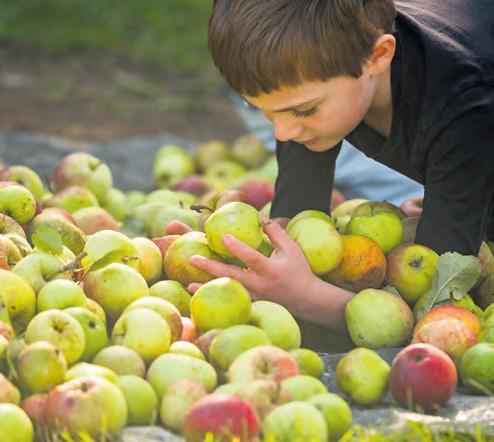
As part of NT Hinton Ampner’s harvest celebration, join experts from Sparsholt College to learn about the world of apples on Saturday, 26th and Sunday, 27th October, from 10am until 4pm both days.
Delight in the wonderful orchard at Hinton Ampner, bursting with fruit and find out about varieties of apples. Booking is not needed for this free event but normal admission applies.
Hinton Ampner NT, nr Alresford, Hampshire SO24 0LA Tel: 01962 771305 www.nationaltrust.org.uk/visit/hampshire/hinton-ampner

They are celebrating the apples in their orchards at NT Killerton in October and invite visitors to bring a bag and follow a trail to one of the orchards to harvest apples for traditional cider making or pick your own to take home.
From Thursday 10th October every day from 10am until 4pm until the end of the month on Thursday 31st October, visitors can follow the trail and pick apples. This event is free, but normal admission charges apply for the venue.
On Wednesday 16th and Thursday 17th October join a guided walk through one of Killerton’s heritage orchards to the home of Killerton’s 200-year-old apple press.
The walk starts at 1.30pm and ends at 3pm each day. Booking is essential, prices £7 adults, £3 children. Assistance dogs welcome. Phone 01392 881345 to book a space.
Killerton NT, Broadclyst, Exeter, Devon EX53LE. Tel: 01392 881345
The team in the orchards at Barrington Court near Ilminster between Monday, 28th October and Sunday, 3rd November welcomes visitors to gather in the windfall apples with their mini wheelbarrows. The orchards are home to over 100 varieties of apples and once collected, they will be turned into delicious cider. The harvest days start at 11am and end at 3pm. Check in at reception and you will be directed to the orchards where you can collect your wheelbarrow. It’s a free event and there’s no need to book but normal admission prices apply.
Barrington Court NT, Barrington, Ilminster, Somerset TA19 0NQ Tel: 01460 241938 www.nationaltrust.orguk/barrington
Orchard Harvest Day is back at Winterbourne Medieval Barn, seven miles north of Bristol, on Sunday 6th October, a fun day out for all the family. Enjoy entertainment from ferret-racing, the 5678 School of Dance, Winterbourne Down Border Morris Dancers, Same Same but Different Puppeteers, and live music from Bygonz wandering minstrels and Piratitude, Bristol’s pirate-themed singalong folk-rock and sea shanty band.
The day starts at 11am and goes on until 4pm, with a variety of artisan crafts stalls, food and drink available all day, children’s competitions and activities, face painting and a pocket money stall. Admission £5 adults, £1 children. Well behaved dogs on leads are welcome. There’s free car parking at Winterbourne Academy and a free shuttle bus.
Winterbourne Medieval Barn, Church Lane, Winterbourne BS36 1SE www.winterbournebarn.org.uk
Blackmoor Estate’s famous Apple Tasting Day has been running for over 50 years, and returns on Sunday 13th October from 10am until 4.30pm.

The popular free local event at the estate near Liss is in aid of local charities and is an opportunity for fruit enthusiasts to taste a wide variety of the old and new apple and pear varieties grown at Blackmoor – from traditional favourites like ‘Cox’s Orange Pippin’ and ‘Norfolk Royal Russet’ to exciting new varieties like ‘Opal’ and ‘Rubens’.
Apple experts will be on hand to identify mystery apples, fruit trees and plants will be available from the nursery, and as usual there

will be a range of other attractions including a rural craft fair and demonstrations, a community fete, local produce stalls, horse and cart rides, cakes and teas;,climbing wall, Morris dancing and cider of course! Free entry. Dogs are welcome on leads but not inside the craft barns and food hall.
There will also be Apple Picking Days in October, on Saturday 5th and Sunday 6th October, and on Saturday 19th and Sunday 20th October, 9.30am until 4.30pm each day, the chance to stock up on your own autumn apple and pear supply from Blackmoor Estate’s orchards - ‘Cox’, ‘Bramley’, ‘Egremont Russet’, ‘Conference’, ‘Comice’ and more available. Blackmoor Estate, Blackmoor, Liss, Hampshire GU33 6BS www.blackmoorestate.co.uk

Cockington Court’s annual Apple Day returns on Sunday, 13th October between 11am and 4pm with free entry to visitors, a wide range of activities to entertain the whole family including arts and crafts, live music and over 40 market stalls selling an array of food, drinks and hand-made crafts.
A traditional apple press on the front lawn will be the star attraction with Gerry Stuart and his demonstrators turning apples into juice and describing how to transform the juice into delicious homemade scrumpy. Visitors are welcome to bring their own apples for pressing, for a small donation. Alongside Apple Day activities, resident Cockington Court makers will be showcasing their skills in their studios, providing visitors with the opportunity to learn about their craft, and the free, piratethemed Sculpture Trail runs until the beginning of November.
Cockington Court, Cockington, Torquay, Devon TQ2 6XA.
By the time October rolls around, your garden may begin to look a little bit of a mess due to dying leaves, collapsing plants and empty borders. However, this is the perfect opportunity to begin cutting back and tidying up. Autumn is most definitely and officially with us, in all its golden glory. The ground is wet with dew in the mornings and the garden starting to be covered in cobwebs, but some days into the month will feel glorious and still warm. On top of regular tasks such as keeping your lawn tidy and plants cut back, there is also a collection of jobs to ensure your garden is prepared for frosts as winter approaches. So, try and complete as many maintenance tasks as you can before moving on to the rest of this month’s gardening jobs. Preparation for winter is in full swing – fruit and autumn veg are starting to be ready to be brought in and stored, and plants should be cut back, wrapped up or brought inside to help them survive the chilly winter temperatures.
A welcome addition to any garden, spring flowering bulbs require little work and maintenance yet produce fabulous stunning early season displays. The good news is there’s still time to get the bulbs in the ground.
The unmistakable swathes of stunning daffodils and the beautifully vibrant colours of crocus, iris, tulips and other bulbs bring to gardens in the spring may seem miles away at this time of year, however, if you are looking to add or create a new spring display now is the time to plant.

Bulb planting is straight forward and easy even for the most novice gardener. When planting out always plant in groups, minimum of six to nine bulbs per group to give more impact and a better show, increase quantities if a larger area. For the correct spacing, plant bulbs twice the width of the bulb apart at the depth of two to three times the depth of the bulb with the shoot facing upwards.
Bulbs are a super choice for containers and easy to grow, again best planted in groups but may need to be smaller depending on container size, using a mix of multipurpose compost and grit with plenty of drainage when potting up. Recommended bulbs for containers include compact varieties of daffodils, tulips, iris and muscari. Some bulbs such as the delicate snowdrops perform much better when pot grown, once establish in the pot they can be transferred into the ground or divided and re-potted.
The fabulous early season splendour and colour camellia and rhododendron bring to many gardens take the plants many months to prepare.
Next season’s flower buds start to form very early at the end of summer and enter autumn, the bud development will be well under way. To ensure continued healthy growth and development of flower buds it is crucial the plant is kept well-watered.
Early October can often be fine and dry so it’s important to make sure the root system remains moist and well-watered (not over watered) helping the buds to swell and grow. Always water around the base of the shrub, both have dense foliage and if watered from the top water can be diverted away from the base by the foliage, meaning insufficient water reaches the root of the plant causing it dry out. Failing to look after them during the crucial autumn period may result in buds drying out and dying, putting at risk the muchanticipated spring extravaganza. 1

Broad beans are very hardy and some broad bean varieties produce much earlier crops if sown in the autumn and certainly in October. On heavy soils that stay wet through the winter they can be prone to damping off or rotting. So, it can be a good idea to start them off in pots in the greenhouse and plant them out in the early spring as the soil warms up again. You need hardy varieties such as ‘Aquadulce Claudia’ to make the most of over-wintering.
If you’ve got tender plants, such as canna, now’s the time to bring them indoors before they get killed by the frost.
Choose a light, frost-free place such as a greenhouse or coldframe. Then keep them on the dry side during the winter, so they don’t put on much growth.
The plants can then be brought back into growth in spring by gradually increasing the amount of water they receive.

5 4
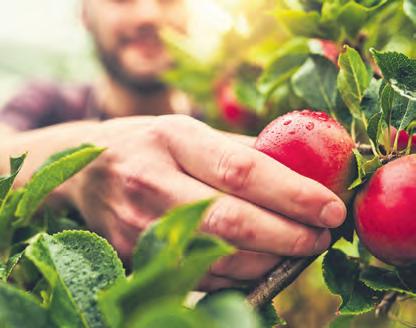
October sees the last chance to harvest late season fruit such as apples, pears, medlars and autumn raspberries.
It’s important to pick before the cooler wetter weather arrives later in the month spoiling what’s left of the crop. With a gentle twist ripened fruit will come any from the tree quite easily. Wasps usually feed on the sugary spit produced by larvae in the nest, however there will be no larvae left at this time of year and the wasps will be looking elsewhere for their sugar fix, fruit trees being their perfect source.
Remove any rotten and diseased fruit from the tree to help control and stop the spread of disease, it’s important leaves and fallen fruit are raked up to again help with disease control. Take off any unripened fruit by the end of October, the weather at this stage of the season will be too cold for fruit to ripen. Leaving the unripened fruit on trees will take valued energy out of the tree as well as leaving the tree open to disease.
Fruiting trees will have expelled huge amounts of energy through the growing season producing their fruit and will need a nutritional boost, however, now is not the time to do it. If fed now they would produce young tender growth, this growth would be damaged as soon as frost and cold weather arrives. Generally, fruit trees are best fed with high nitrogen feed in the spring giving the tree some well needed sustenance as the growing circle begins again.
Late season apples, if stored in a well ventilated frost free environment, will last well into November and December. Pears have a much shorter shelf life of around three weeks. If you have a glut of autumn raspberries and struggling to use up these can be frozen and used as and when required.
Late autumn and winter are the perfect time for planting trees and time especially to look to fruit trees. If you are dreaming of a new orchard, now is the time to start planning. A visit to one of the many apple days around the south and south-west is a great opportunity to try some of the less well-known varieties. Growing your own is a great opportunity to be able to grow one of the several thousand varieties that aren’t available in the shops.
Frosts will eventually bring an end to their glories but until then do keep deadheading. A quick way to tell flower bud from spent head: the spent heads are pointed in shape, the buds round.
If left over winter, the soil will lose nutrients. Use organic mulches to protect it and give good structure for next year’s growing season. Best mulches are a thick layer of autumn leaves, wetted so that they don’t blow away,straw, grass clippings and autumn leaves mixed together, cutback plants such as sweet peas, peas or runner beans, chopped up sheets of newspaper, covered with damp grass clippings to weigh it all down.

8
Prepared hyacinth bulbs can still be planted now. Use bulb fibre or generalpurpose compost but don’t be tempted to use ordinary soil which might contain worms. Bulbs should be close but not touching either each other or the sides of the pot. Fill with compost allowing the tips of the bulbs to show. Water, but don’t overwater, and place in a cool dark cellar, garage or somewhere similar. Check regularly, watering a little if necessary. You don’t want them to dry out. Once the shoots are a couple of inches high you can bring the pots indoors.

11
Rhubarb needs revitalising now and again. Dig up big old clumps and divide into pieces using a sharp spade, making sure that each division contains a piece of root and a shoot, then discard the old centre. This is also the time to buy and plant new rhubarb crowns.
Plant new crowns any time from now onwards through to the end of November.
On wetter soils, planting with the buds just raised out of the soil may help prevent rotting. of the plant. If planting more than one crown, space plants one metre apart, with one to two metres between rows.
13
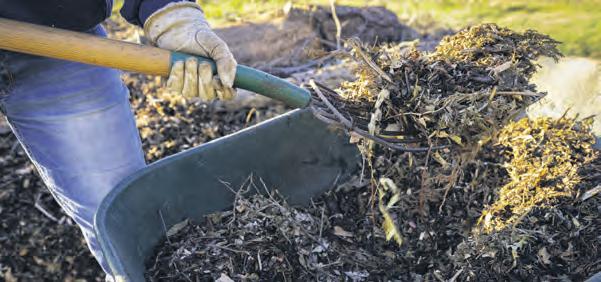
Wildflowers need an October trim
9
Wildflowers only need to be cut down once a year. Wait until they have finished flowering and the seed heads have ripened, adjust the lawnmower wheels onto their highest setting, remove the grass collection box and run the mover over them, or if you fancy a lot of exercise, try a scythe. Leave the cuttings on the ground for a few days to allow any seed heads to dry and for the seeds to fall.



Late October is the ideal to plant garlic, because it needs a one-to-two-month cool period to encourage good bulb development before the spring.
To plant garlic, all you need to do is break up a bulb of garlic into segments/cloves, and plant them in well-drained soil, two cms below the soil’s surface. The flatter end (that you would normally trim off) should be pointing downwards. Try to choose a spot that’s open and well-lit to allow the garlic to receive maximum sunlight throughout the winter.

In terms of spacing, it’s best to allow 15cm between individual cloves and 30cm between each row of cloves. Garlic doesn’t do too well in an acidic soil environment (below pH of 6.5), but it’s easy to increase the pH of your soil by adding garden lime to it during the autumn and winter months.
12
10
Cut back perennials that have died down
Perennials are not demanding plants, but trimming them after flowering finishes in autumn helps improve their appearance and flowering. But you can leave some stems over winter to provide homes and food for wildlife, and then trim back in spring.
Cutting back herbaceous plants during autumn restores order and tidiness to the garden. However, this removes potential winter interest, in the form of height and structure, plus food and habitat sources for wildlife so think about delaying the cut back until spring.
Make the most of your fig tree
If you have a productive fig tree, take cuttings now. They should be about a foot long, this year’s growth, with the softer tip removed. Cut the tip-end at an angle so you know which end is up then insert cuttings into a trench of well-drained soil.
14
It’s not too late to get your spring cabbage plants in the ground. ‘April’, ‘Durham Early’, ‘Offenham 2’, and ‘Spring Hero’ are varieties that you could try. Although they won’t grow much over the winter, they should flourish next spring.
You should space young cabbage plants as far as 18 inches apart, to give them plenty of space to grow. They’ll also need a good amount of water when they’re first planted. Cabbage plants are quite hardy, so they should be perfectly fine during the winter, unless it’s exceptionally cold. In this case, you might find it helpful to use a cloche (a cover) to protect them.
One of the main issues that young cabbage plants face is that they risk damage from pigeons. To counteract this problem, you can stick a couple of feathers into a potato and hang it from a string over your cabbage patch, to ward them off. The pigeons will think that your cabbages are being guarded by another bird and will usually keep away.
Autumn’s colour palette of reds, oranges, yellows and golds sweeps across the countryside through October, November and into early December.
Crunching leaves, vibrant views and the red-tinted, golden hues of autumn make this earthy season the perfect time to visit our beautiful gardens and countryside. It’s hard to beat the sense of magic that you get when you walk beneath the kaleidoscopic canopies of oaks, beeches, birches and sycamore.
Every autumn, gardens and woodlands dazzle us with colourful displays as the trees begin to prepare for winter. It’s a beautiful time of year and it captures the attention of many of us, with so-called leaf-peeping (the American term for getting out and enjoying autumn colours) growing in popularity in recent years.
The timing can differ in some years, usually depending on whether the UK experiences an ‘Indian summer’ – the name given to an unseasonably warm, dry period of weather during Autumn. This allows the leaves to continue photosynthesising later into the season, delaying the changes in colour.
As ever there are some wonderful days out in store:
The turning of the season from summer to autumn brings cooler days and richer colours to the gardens and arboretums that open for the National Garden Scheme this October. With over 260 gardens to visit from the Cumbrian hills to the coast of Cornwall, there’s still a sumptuous tapestry of gardens large and small to inspire you this month. Full of fabulous planting schemes and garden owners keen to share their top tips, and with many selling plants and homemade teas, a garden visit in October is a fabulous way to celebrate the autumn and enjoy the great outdoors. Find a garden to visit near you: www.ngs.org.uk



Don’t miss the worldfamous colour at Westonbirt, The National Arboretum this autumn! Westonbirt Arboretum is playing a vital part on the world stage with its work in global tree conservation. Did you know that living within Westonbirt’s collection, there are 100 of the world’s threatened tree species? Along with all the trees providing a riot of colour, there are also exciting walks and family activities lined up, explaining the vital work Westonbirt is doing to protect and conserves trees. Together, it’s a case of creating a world where trees thrive for people and nature.

Forestryengland.uk/westonbirt/autumn
Westonbirt, The National Arboretum, Tetbury GL8 8QS
You can celebrate the bounty of autumn with a weekend of cookery demos, expert talks, family fun, live music and fabulous food at RHS Garden Rosemoor’s Festival of Flavours, on the 5th and 6th October.
Meet local traders and craftspeople and browse seasonal produce, deli treats and gifts before heading out to the gardens.

Food writer Mark Diacono will teach you how to make a botanical-themed cocktail using homegrown ingredients, Tineke Cooks will guide you through delicious seasonal recipes and Cornish Country Cordials will show you the art of pasteurising.
Families can enjoy tree climbing and forestry skills, and see fascinating heavy horse demonstrations in the Lower Woodland.
Admire the Devon orchard apple displays and try a few to decide which variety tastes best! Then relax with a drink made three miles away at Honeywood Orchard’s cider bar and enjoy delicious food as well as live music in the Stream Field.
RHS Garden Rosemoor, Torrington EX38 8PH
Boscrege Caravan and Touring park in Cornwall is a peaceful and picturesque park, set at the foot of Tregonning Hill, Godolphin National Trust and amongst tranquil Cornish lanes in an area of outstanding natural beauty. The park, open all year, is close to the Cornwall coast and a few minutes’ drive to Praa Sands, one of Britain’s nicest beaches. So, if you are looking to take a luxury holiday (doggie friendly with dog friendly homes and on-site designated fields for the dogs too) in Cornwall in a either a self-catering caravan, lodges, touring caravan or even purchasing your very own holiday home then contact Boscrege Caravan and Touring Park.
Bocsrege Caravan Park, Boscrege, Ashton, Cornwall TR13 9TG Tel: 01736 762231 www.caravancarparkcornwall.com
There’s the wonderful opportunity to enjoy tranquillity, autumn colours and warming soups at Lukesland Gardens in Ivybridge.
Tucked away on the southern edge of Dartmoor, just north of Ivybridge, Lukesland is a wonderful place to enjoy autumn colour. The shelterbelt of beeches, planted by the Victorians to protect this 24-acre garden from Dartmoor winds, turns to gold, while more exotic species such as acers, cercidiphylum, cornus, enkianthus, ginkgo and swamp cypress reflect their autumn tints in the pools of the Addicombe Brook. Visitors often comment on how peaceful the garden is, with the gentle sound of the tumbling stream constantly in the background, as you wander on twisting paths through this woodland valley, with new views around every corner.
Openings are on Sundays and Wednesdays 11 am to 5pm from 9th October till 13th November. No pre-booking is required. The tearoom is open with a simple menu of home-made soup and cakes. There is also a fun trail and a ‘Sound and Story Garden’ for children. Dogs are welcome on a lead.
For more details about Lukesland phone 01752 691749 or go to www.lukesland.co.uk Lukesland Gardens, Lukesland House, Ivybridge PL21 0JF















Batsford Arboretum is famed for putting on a show-stopping display of autumn colour, thanks to the magnificent collection of Japanese maples, Sorbus, Euonymus and cherries. Enjoy 60 acres of magical walks amongst a kaleidoscope of reds, pinks and golds against the backdrop of stunning Cotswolds countryside.
Visit the garden shop for all your gardening essentials and the walled garden plant centre for a vast selection of quality plants. To top it off, enjoy a delicious breakfast, lunch or afternoon tea at the Garden Terrace Café.
Plan your visit to the Arboretum in advance during autumn by booking via www.batsarb.co.uk
Batsford Arboretum & Garden Centre, near Moreton-in-Marsh, Gloucestershire, GL56 9AT Tel: 01386 701441




Fine Autumn Colour Pools & Waterfalls
Home-made soups & cakes
9th October - 13th November on Sundays and Wednesdays 11am - 5pm
Harford Ivybridge PL21 0JF Tel 01752 691749 www.lukesland.co.uk
Soak up the spectacular colour... at Batsford this autumn, browse our garden centre and gift shop and enjoy delicious food from our café. A perfect day out for all the family – including the dog!

www.batsarb.co.uk
BATSFORD ARBORETUM AND GARDEN CENTRE
Batsford, Moreton-in-Marsh, Gloucestershire GL56 9AT. Tel: 01386 701441 E: arboretum@batsfordfoundation.co.uk BatsfordArboretum@BatsfordA

Dorset gardener Andrew Joseph shares the story of his beloved pear tree which once faced being cut down but now is again a huge provider of autumn fruit.
I hope you think the story of my pear tree is worth sharing with your readers. It is about 30 years old and as I look out across the garden it is laden with perfect Conference pears.
There must be at least a hundred pears.
That does mind present a bit of a problem as any pear lover knows we pick them off the tree while still nice and firm and then bring them indoors to ripen only to see them all ready to eat at the same time. Neighbours and friends will benefit however.
How the tree got to this state of harvest abundance is a bit of a mystery. Ten years ago, it started to decline badly. Early in the summer the leaves started to look diseased and the fruit pock marked and far from perfect.
It did produce some fruit, but it was a shadow of its former self.
I tried to help it - making sure it was properly mulched and all the weeds were cleared from the base of the trunk.
The decline was gradual but very noticeable. Of course, pears need pollination from a different cultivar that flowers at the same time, so I relied on pollen from a neighbouring pear tree- again Conference variety so was this a factor?
The problem wasn’t pollination however, it was the fact that the tree was clearly not healthy and was dying.
Five years ago, a friend said I should try a ruthless pruning session, cutting out not only deadwood and cross over branches but try to give the whole tree a new shape and air into the heart of tree.
It didn’t seem to do any good. By now the tree wasn’t producing any fruit at all. I should mention that when the tree was healthy it would now and again have off seasons – a year when there would be no fruit – as if the tree was having a holiday and resting up.
That’s the story my wife came up with anyway!
On several occasions during tidy ups I got the chainsaw out and thought long and hard about taking the tree down and trying again by planting some new pear trees as I think having one or two trees in any orchard is a must.
There’s a happy ending to this story. Two years ago after a warm March and April the pear tree started to produce lots more shoots – I mean lots. The leaves lost that mottled, diseased early spring look and took on a lime green healthy appearance. It produced more blossom than I have ever seen and through the summer the fruit appeared and started to mature.
We couldn’t believe it and many is the mid-summer evening when we’d both take a walk down the garden with nothing in particular in mind but we both knew we wanted to have a look at the pear tree.
So, for two autumns now the miracle has continued.
I can’t think why. My friend said the pruning exercise a few years ago might have taken a few years. Someone else said that pear trees can go through years of being dormant and then a warm spring will bring it to life
So, I suppose the message is never give up on anything. Nature has a way of doing what it wants, when it wants.

We are always delighted to hear from Country Gardener readers who want to share their thoughts, views, ideas and comments with us. Email us at editorial@countrygardener.co.uk
I was bought a vine two years ago by my sister. I didn’t have a greenhouse, but we do have a south facing wall which is a real suntrap. The variety was ‘Muscat of Alexandria’ and on the label it describes it as a delicious flavoured grape variety with an intoxicating perfume. When I did some online research, it appears as a variety it can be temperamental and needs careful pruning and training. I have done little with apart from pin it to the wall in three parallel branches. The result has been dramatic. Large bunches of grapes, disease free. I’m not sure what we will do with them as they may not all ripen but what a success story.
Wilhelmina Brookes Boscombe

I read your story about toads climbing trees with interest, last year we put a couple of bat boxes out the in the garden and one Sunday my teenage son came in shouting with excitement from the garden and said he had seen two large toads almost racing up the tree to get to the boxes. Nobody believed him but he was right of course and now the toads seem to have made the boxes their summer home and we take the sight of them for granted.
Carol Ann Harnett Cirencester

Our bamboo hedge has been a great success
One of your letters last month was defensive of bamboo which suddenly seems to be an object of derision from gardeners and homeowners. I’ve read about how invasive bamboo is and there even was a full ten-minute programme on the regional evening news warning people against it.
Why has it suddenly become so despised? The strength, grace and vigour of bamboo will provide privacy in any garden like no other plant. There are many types of bamboo some of which will take many years to grow to an effective height.
Other types sich as Pseudosasa and Chusquea are more problematic and yes you need to stay clear of these. But it seems the whole of the bamboo family has been outcast. We put a hedge in a few years ago. We have a noisy neighbour who parks caravans up against the fence so wanted something fast growing and strong.
The bamboo we used comes from the Phyllostachys family which is more clump forming in nature. There was some spread, but we wanted that to create a dense covering. The result has been dramatic, and we control it severely by annual pruning and installing a root barrier at the limit where we want it to spread. Gardeners are always in charge surely and should be able to control such plants as bamboo which I think have a lot going for them.
Dave Moreland Swindon

My friend and I read in your lovely magazine about the Festival of Roses taking place at RHS Rosemoor. I am putting pen to paper to say it was a joyous trip we decided to make – a round trip of about 50 miles. We are both rose lovers and have been for some time and had never been to RHS Rosemoor so it seemed a good day out in prospect. The weather was wonderfully warm and mostly sunny and the roses on display were just breath-taking and all of them seemed to be wonderfully cared for. We I think will go to the festival again as there is so much to take it. A lovely rose filled day out.

More gardening words
It was a delight to read the literary quotes last month. I too have a notebook with gardening words and things I enjoy. One of my favourites comes from a delightful book called Garden Rubbish
“Take it from us, it is utterly forbidden to be half hearted about gardening. You have got to love your garden, whether you like it or not”.
Richard Yassall Cirencester
I wish some owners who open for the NGS Open days would treat young children with the same sort of dislike they do dogs when it comes to entering their gardens. We visited two NGS gardens in August while we were on holiday in Devon. Both visits were ruined by young children on holiday running around being noisy and disruptive. In each case the parents seemed to have little control or interest in control and the visits were spoilt. The garden owners didn’t seem very interested in saying anything, so we left. I am often not allowed to take my dogs into NGS gardens near where I live but I can assure you they are much better behaved than these children were.
Marilyn
Cheltenham
Davies

I so enjoyed your September magazine and the quotes from the teacher’s daughter. This may not be very literary, but it makes me smile.
“Sometimes we try and be a bit too clever in this world. Take the poor old gardener who’s plagued by blackfly. He’ll spend a small fortune on sprays and things and all he needs to do is take a little soil from the bottom of the plant and springle it over those blessed blackfly. That will almost certainly finish them off…it gets in their teeth you know”. Fred Streeter
Lionel Drew Bideford
As we start to enter the darker, colder months I would urge more of your readers to make some creative use of their windowsills - a really underrated resource in the home of an active gardener. Windowsills are very useful for an initial few weeks at the start of the growing season to help seeds germinate. You can use them for a short-term boost to get seeds under way rather than for growing to planting out stage because seedlings cannot live too long in the one-sided light of windows before they become tall and thin. We have three windowsills and they are an important part of our gardening year.
Pammy Harrison Chichester
Our hugely popular gardening advice pages has rightly an autumn feel from readers seeking help for pruning, planting and pest problems. If you would like help on gardening matters email us at editorial@countrygardener.co.uk

I am a relative newcomer to gardening and enjoy your magazine enormously – full of well-judged advice. I would like to know if there is a rule of thumb for when it comes to pruning.
Exmouth
There isn’t a hard and fast rule. One way of thinking about it is that all plants that respond well to pruning have evolved around herbivore pressure: a deer or rabbit eats it and, instead of that being the end of things, it re-sprouts. A list of what needs pruning when is the subject of many books . Generally, just remember pruning brings renewal and new growth. Roses respond well to pruning; they also have thorns, which keep herbivores from destroying the plant. So, thorns and lots of soft leaves suggest the plant can be pruned hard, even back to woody material. Plants with strong essential oils – rosemary, thyme, lavender – only really exhibit those oils in leafy material, rather than the woody parts, again to keep herbivores off. So you can prune the soft bits of these plants, but if you cut back into woody material, they don’t tend to re-sprout. Fruit trees need attention in the autumn, cutting out diseased and deadwood. Some plants like buddleias love hard pruning and you can take them down to almost soil level.
Are there any herbs which I can keep alive and thriving throughout the winter? I am very fond of herbs in my kitchen garden but have only just started growing them this year.
Pam French Barnstaple

There are lots of different varieties of herbs that overwinter very well. However, there are some herbs that are annual herbs, they’re not meant to overwinter, rather to be planted each year. There are also herbs that are much more coldhardy or frost-tender. So, you’ll want to know what your climate is like (what’s your average lowest temperature) to know what herbs are best.
You will in the southwest be able to overwinter rosemary, lavender, echinacea, oregano, thyme, peppermint, sage, and lemon balm.
Rosemary is one that many people have a hard time overwintering, but it’s not usually due to the cold. It’s because the plant doesn’t like to have wet feet. So, if you live in an area that gets a lot of rainfall without good drainage, it may just be too wet. You can grow rosemary successfully in a container to ensure good draining.

How often should we replace the soil in garden pots? At the end of every season the soil is pretty dried up but I never know whether to start again.
Ralph Johnson Minehead
Eventually, container plants need to be moved to a bigger pot, which should be done in early spring. You usually have about three months’ worth of usable food for your plant in your compost. To add fresh compost to your container, first remove a little of the old compost. Then. replace a third to a half of the existing compost with fresh. When repotting isn’t required, remove 5cm of old compost from the top, and replace it with fresh compost.

How do I keep an orchid alive? I was given a lovely variety by my grandmother and am worried I won’t be able to keep it alive. Some flowers have already started to drop. I should add I don’t have the greatest track record with plants.
Anna Graham Poole
Many write orchids off as dead after the flowers drop, but they are probably entering a rest period before blooming again. Other reasons for flowers dropping include lack of sunlight, underwatering, overwatering and excessive sun exposure.
But you can help your orchid thrive. Position it in a location that receives bright, indirect light, ideally east-facing. Water weekly with tepid water, ensuring that the roots are thoroughly moistened but not waterlogged. Fertilise once a month from March to November, using a balanced orchid fertiliser.

When the flowers begin to fade, don’t despair! Pruning the orchid correctly can encourage future blooms. You can either trim the flower stalk a few centimetres above the leaves, which typically results in reblooming within a year, or you can cut the stem just above the first node. This method can prompt the orchid to reflower within a shorter time frame, typically eight to 12 weeks.
I am always torn as to whether I really need to add fertiliser to my plants -houseplants and other outside newly planted shrubs. Is it a waste of money? When should you fertilise? And do all plants need it?
Sammie Porter Southampton Ideally, we wouldn’t ever need to feed our plants, and if you’re growing in good quality soil and mulching annually, you probably don’t need it. There are always exceptions however. Sometimes feeding is helpful, even necessary – when you are growing hungry crops (tomatoes, say) in containers, or if your plants are not thriving as you’d hope and you suspect they don’t have the nutrients they need to flourish. Roses respond well for example to specific plant foods. A good quality general fertiliser won’t do any harm. Many gardeners do believe fertilising little and often is essential to accelerate growth but the jury is probably out as to if it is essential.
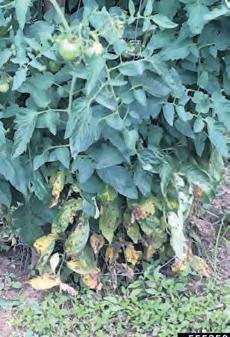
I love growing tomatoes and in recent years have had at least ten to 15 plants in the greenhouse or just outside it against the wall. For the last three years now, they have all failed and I am desperate to find out what is happening. After about ten weeks when the plant is putting on a lot of growth the bottom stem and leaves began turning yellow and a white substance is now evident on the dying parts. Is this a fungal disease or pests?
Pete Harris Taunton
It does sound like a disease. It is likely a blight (there are several) as these tend to move from the bottom of the plant upwards. If the problem is as you say recurring it is essential not to use the soil or compost from a blight affected greenhouse crop in the following year. So, stage one is to start again with the soil/compost as the spores causing the disease need to be eradicated. It may even be an idea to leave using the soil for tomatoes for a season to really get rid of what seems to be a serious problem. Otherwise, there is little you can do as blight is a real killer of plants.
I grow several plants from the cucurbit family including cucumbers, gourds, melons, and watermelons every year. I have had pretty good yields every year but this year all the species got wrecked by disease. Please help me identify what this calamity of a disease is! Cucurbits are my favourite food to grow and I really don’t want it to repeat the next season. The disease starts with yellow spots on the lower leaves, progresses to upper mature leaves and in a week’s time, the plant starts dying.
Freda Richardson Liss
The disease to hit all your vegetables is almost certainly magnesium and /or potassium deficiency. pH balances could also be a factor -so to start with this autumn when you have the plot cleared run some tests on your soil and see where it is on the pH scale. It is more than likely that a good potassium feed will correct the problem.
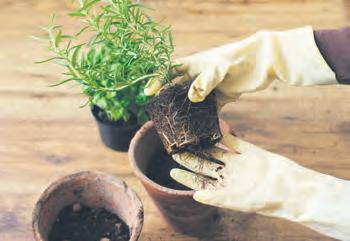
How do I know if my plant needs repotting, and how do I do it?
Margery Davis Martock
The distress signal of any plant which needs to be repotted takes numerous forms although a few can be symptomatic of inadequate light levels and root rot. They include wilt, quickdrying soil and roots creeping out from the drainage hole, if your pot has one. Yellowing may also occur when insufficient or ‘tired’ compost leads to a lack of available nutrients. To repot, edge around the pot with a trowel before transplanting into a larger container preprepared with fresh compost. A good rule is to bump up pot sizes incrementally: a small plant in a large container leads more quickly to rot, with soil remaining soggy where roots cannot yet reach it.

I was told you should never feed a wisteria, is this true?
Mark Barrett Portsmouth
This has the sound of an old wives’ tale about it. I’m afraid this is about as true as the number of spots on a ladybird telling you how old it is!
It’s not true, you can feed your wisteria. For example, in summer, once flowering is done, the green growth of the wisteria from the current year can be cut back, leaving five or six leaves per branch. At this stage an organic plant feed will not only will this keep it looking good and controlled, but once again it will encourage more flowering buds rather than leaf buds. Whilst the wisteria is young, prune like this every year, helping to guide it. Feed monthly with a high potash fertiliser during the growing season, to encourage more flowers to bloom. Water and feed potgrown wisteria weekly. And in autumn, mulch with organic matter, like well-rotted horse manure or homemade compost.
Why is there white foam on my lavender plants?
Brenda Porter Salcombe
We have moved into a new garden which at the moment doesn’t have any roses. So, one of our first tasks is buying a cross section of varieties and get them planted. But when should we start planting?
Debbie Isleworth Painswick
You have a pretty free hand really and you can plant roses all year round providing the ground is not frozen, too wet or two dry. Bareroot roses are best planted in late autumn at and from late winter to early spring, before growth resumes. Avoid planting in the middle of winter when the ground is frozen. Containerised and container-grown roses can go in all year round all year round, provided the ground is neither frozen, nor very dry.
If you want to be specific the general view is planting will be acceptable when temperatures are between 40°F and 60°F.
Our popular gardening themed crossword is compiled by Saranda which over the past year has become enormously popular with readers. The winning entry to be drawn by us will receive £100 of RHS gift tokens. Completed entries should be sent to Mount House, Halse, Taunton, Somerset TA4 3AD. Closing date Thursday 1st November. The August issue winner was Claire Riley from Minehead.
This is quite a common sight on plants, and whilst it looks quite worrying, it is nothing to panic about. No, this foam is not harmful to the plant.

In fact, you can leave it there as it increases the biodiversity in your garden.
It isn’t anything produced by the plant itself, but instead by an insect, the juvenile froghopper. This insect is otherwise known as the spittle bug, and it is easy to see why.
The white foam is to protect the larvae from predators and stops them from drying out in the heat. This foam enables the larvae to feed safely on the plant as it develops into its adult form.

My much-loved peach tree is again affected by peach curl. It is exactly the same as last autumn and very frustrating. What’s the best way of getting rid of it?
Caroline West Bournemouth
Peach curl is becoming very common in the southwest. It is caused by a fungus, leading to reddening and twisting of the leaves. Try to keep the shoots dry. Where peaches are grown trained against a fence or wall, a rain shelter of a plastic sheet is effective at preventing infection. Cover the top of the tree and front within 30cm of the ground, with ends open to allow access for pollinating insects. Put this up in November and remove in mid-May. Prompt removal of infected leaves before the bloom of white spore appear will help reduce the fungus in the following year. Dispose of the leaves, don’t compost them.
ACROSS
1. A secular day of observance where people plant trees (5, 3)
5. City in the Basque region of Spain (3, 9)
13. The genus of plants Helenium is named after _____ of Troy (5)
14. Farming in water (11)
15. Derogatory term for an Englishman (3)
16. He wrote The Grapes of Wrath (9)
17. Cetraria islandica (7, 4)
18. The primrose family of flowering plants (11)
19. Genus of flowering plants in the sunflower family (9)
20. Cool, arid region in Chile (7, 6)
22. They come from handling poison ivy? (6)
25. A name for self-heal, __________ herb (10)
27. Giant lumberjack and American folk hero (4, 6)
29. A Brazilian cottontail rabbit (6)
30. Where one might be in a similar difficult situation? (2, 3, 4, 4)
33. Common name for Australian plant Macrozamia communis (9)
35. Arenga pinnata (7, 4)
37. A person who is 100 years old (11)
39. Common name of garden weed Taraxacum (9)
41. Used for travel over snow (11)
42. Beatings or floggings (11)
43. Well-loved vegetable of the genus Allium (5)
44. Warts found on cattle and horses (12)
45. Stays in bed longer than usual (6, 2)
DOWN
1. A garden pest such as blackfly (5)
2. A dancer whose name is often applied to fuchsia? (9)
3. Family to which the buttercup belongs (13)
4. A public walk shaded with trees (7)
6. Ancient Greek mathematician (10)
7. Find solution to (5)
8. Genus of ornamental vines belonging to the Nyctaginaceae family (13)
9. Sylphlike or willowy (7)
10. Failure to observe standards of honesty (11)
11. Colourful annuals such as Lady Lisa (8)
12. The American activity of gathering certain fruit (14)
18. A popular flatfish eaten in the UK (6)
19. Informal jumbles of flowers, herbs and vegetables (7, 7)
21. To be unhealthily emaciated like a garden tool! (2, 4, 2, 1, 4)
23. Favourable or rose-coloured (French) (7, 2, 4)
24. A genus of gymnosperms including bago and melinjo (6)
26. In a vase, changing flowers again (11)
28. She works in a hospital (5, 5)
31. The states or qualities of being opaque (9)
32. The x-coordinate of a point (8)
34. Small circular areas often around pimples (7)
36. A lucky omen or gift given at New Year (7)
38. An ethereal fluid flowing in the veins of the gods (5)
40. A lightweight fabric named after the French for Anne (5)
Devon gardener Alison Morris has a passion for growing lots of tulips - and enjoys the symbolism they evoke
I like daffodils a lot and my garden reflects that, I hope, and every spring we look forward to the yellow force they bring with them resisting somehow bad weather and winds.
My true passion however is for tulips, and I have been collecting caring growing them here in Devon for over 25 years. I only have a half-acre garden but I would think I have over 3,000 tulips and I try and add to them every year.

Tulips are not just spring flowers - they mean so much more.

Why do I love them so much?
In essence, tulips are the perfect blend of effortless beauty and durability making them essential for gardeners like me who want to enjoy their lives both in and out of the garden.
I love the symbolism which has grown up alongside tulips. I love the huge variety of colours , styles and petal shapes.
Tulips are not just spring flower. They mean so much more.
The most known meaning of tulips is perfect and deep love.
As tulips are a classic flower that has been loved by many for centuries they have been attached with the meaning of love. They’re ideal to give to someone who you have a deep, unconditional love for, whether it’s your partner, children, parents or siblings.
As tulips bloom at the beginning of spring they also have a profound spiritual meaning of rebirth. If you know someone who is going through some life changes, taking on new adventures and challenges or have welcomed a new addition to the family, a lovely bouquet of tulips would make a wonderful gift.
Since the Victorian era tulips have also been a symbol of charity. With its cheerful nature and mark of a new season and new beginnings, many charities today still use the beloved tulip flower to represent them.
“Some tulips last so long you could almost dust them off, and others you can’t trust over night.”
— CONSTANCE SPRY
The bright and radiant colour of yellow tulips is always associated with very positive feelings. They represent cheerfulness, happiness, and hope. It is said that yellow tulips would mean “there’s sunshine in your smile” and are often popular for “just because” gifts as they would always bring smiles to anyone.
For example, you probably associate red roses and true love. But, it is not only the red rose that speak of true love, the red tulip is even more a symbol of adoration and passion. The red petals are their lovers’ heart, and the centre is said to have turned black from the flames of passion.
Most people think that tulips originated in the Netherlands, as how iconic they are over there. But, they actually came from Central Asia where they grew as a wildflower. And they were first cultivated in Turkey around 1000 AD. The tulip name actually comes from the Turkish word for ‘turban’ for their similar appearances. Tulips were brought over to Europe in the 16th century by a biologist called Carolus Clusius. And by the 17th century, the popularity of tulips soared. Europeans just couldn’t get enough of the delightful blooms! The Netherlands loved tulips so much a phenomenon named ‘the tulip mania’ came in and caused the price of the flowers to skyrocket, crashing the markets. Their flower buds are known for being perfectly symmetrical. They are the 11th wedding anniversary flower. They can be grown in practically any colour, from snowy white to purples, so dark they are almost black. The only colour tulips aren’t available in is blue. Blue is perhaps trhe rarest of colurs. I have tried to raise one but I think most visitors tell me that they are more lilac or purple.

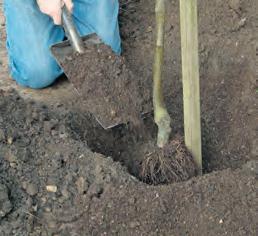

The one job which is critical above all others in any autumn garden is the ordering and planting of trees. Trees remain the key to both happiness and change in the garden and fruit trees especially can provide you with years of delicious harvests.
Trees planted in the autumn have the best chance of getting fully established and requiring minimum attention. Once the weather gets consistently cooler there is no need for watering.
Plants put in the ground in the autumn will be allowed to settle a root system before the onset of the harshest winter months -usually in January and February and when the weather gets consistently colder the plants become dormant until the end of March.
October is also significant to make planned changes to your garden, creating new and interesting areas, to have a complete garden redesign on one level or on another, adding anything from fruit trees to more ornamental statement trees. Either way it’s a month when trees come to the fore.
The Dorset Charcoal Co produces and promotes biochar, a soil additive praised by academics and TV shows for boosting plant growth and capturing carbon. Although seen as modern, biochar is ancient, used by civilizations like those that once inhabited the Amazon (Terra Preta).
Made from cooked plant matter, biochar enhances soil structure, water retention, and nutrient storage, supporting microbial life.
The Dorset Charcoal Co has been making biochar for over 25 years from sustainably harvested hardwood, supplying renowned gardens such as Kew and Highgrove. For more information and to purchase locally produced biochar, visit www.dorsetcharcoal.co.uk
You can control your shrubs and climbers using Rivelin Glen Products uniquely designed Wire Anchors. They are quick and easy to attach to concrete posts (without drilling) to act as an ‘eye’ by threading wire through them to create a trellising system.
The Gripple Trellising System is ideal to use with the anchors as the wire does not stretch, takes up to 100kg load and has a life of up to 15 years. Multiple rows can be achieved with one length of wire and two tensioners. No more sore hands or sagging wires!
Rivelin Glen Products are the main stockists of the Gripple Trellising System. Prices: Wire Anchors from £10.00 for a pack of three; Gripple Starter Kit £19.75. Details available at: www.rivelinglenproducts.com
Email: info@rivelinglenproducts.co.uk or Tel: 01246 462666
Adam’s Apples nursery in East Devon grow the largest range of fruit trees in the west country.
This includes over 200 apple varieties, plums, gage, pears, cherries, damson, quince and medlar, all on a range of root stocks to suit your needs. They also sell bare rooted soft fruit plants.
Adam’s Apples are passionate and award-winning cider makers too, and grow and sell some of the best traditional cider apple trees from Devon, Cornwall, Somerset and Herefordshire.
All their trees and bushes are sold bare rooted, available from late autumn through to spring.
Bare rooted trees are cheaper to purchase and easier to transport than potted trees and are the quickest way for trees to establish and thrive.
They are always happy to offer advice and recommendations for your garden, small holding, farm or community orchard. They can deliver trees throughout the UK.
sales@adamsappletrees.co.uk www.adamsappletrees.co.uk
Tel: 07521 648502
Barthelemy and Co near Wimborne Dorset is a Japanese maple nursery that was founded in 1920. From sourcing and picking the seeds, some years over 100,000 Japanese maples are produced and grown each year on the nursery by the Skinner family. Approximately 12,000 of these seedlings go on to be grafted with named varieties, using techniques passed down through the generations.
Their focus on Japanese maples has allowed them to perfect their growing and grafting techniques, producing some of the finest specimens available in the UK. Barthélemy & Co is not just a place to buy plants, but a living museum of horticultural history, where every aspect of the growing process is done with care and attention to detail.
Visitors to the nursery can see the passion and dedication involved on display and leave with a new appreciation for the beauty and complexity of these unique and captivating trees.
Barthelemy and Co, 262 Wimborne Rd W, Wimborne BH21 2DZ
Walcot Organic Nursery, located in the Vale of Evesham, are looking forward to supplying customers with all sorts of fruit trees over the winter months. Grown in the soil they are available bare rooted when dormant from late November until late March – nature’s time for tree planting. Grown organically you will not be able to find the fruit from many of the varieties in the shops. It is only by growing these fruits that you can enjoy them.
Choose from a wide selection of apples, pears, quinces. plums, damsons and more. Orders may be made via the website www.walcotnursery.co.uk, over the phone 01905 841587 or in person. The website provides a lot of advice on choosing and growing fruit trees. A paper catalogue is also available.
Walcot Lane, Drakes Broughton, Pershore, Worcs WR10 2AL


Quick & Easy Solution to fix wires to concrete posts NO DRILLING - simply clamp the two halves together Three sizes to fit most concrete posts FREE UK DELIVERY
Main Stockists of Gripple Trellising Visit



















Bare Rooted Fruit Trees
Bare Rooted Fruit Trees
Bare Rooted Fruit Trees
Traditional
Traditional
Traditional
• Absorbsimpuritiesfromthesoil.
• Holdsanddeliversnutrientstothesoil.
• Retainsmoistureinlightsoils.
• Improvessoildrainage.
• Conditionsheavysoils.
Availableonline: 750g,3.5kg,10kg 20kg,200kg
Tel.
Tel.
Tel.

We produce and grow the largest selection available in the UK. Plants are pot grown and suitable for garden, patio or bonsai.
welcome Mon-Sat 9am-1pm & 2pm-4pm
Barthelemy & Co (DCG), 262 Wimborne Rd West, Stapehill, Wimborne, Dorset BH21 2DZ
Tel: 01202 874283 enquiries@barthelemymaples.co.uk www.barthelemymaples.co.uk




Want to advertise in one of our features?
We offer special all counties prices when advertising with our features, plus 100 words of free editorial with an advert.
Speak to one of our sales people for more details.
As wildflower meadows become increasingly popular, one native wildflower species is stealing the spotlight: yellow rattle. With its cheery yellow blooms and distinctive rattling seed pods, this annual wildflower is becoming a favourite of gardeners. Its magic lies in its ability to keep bothersome vigorous grasses in check, creating room for a wider range of wildflowers to thrive. This boost in diversity supports a multitude of pollinators and wildlife, making yellow rattle a must-have for any rewilding or sustainable gardening project.
Yellow rattle is a hemi-parasitic wildflower native to the UK and much of Europe. Its name comes from its bright yellow flowers and the delightful rattle of its mature seed pods. But don’t be fooled by its modest looks – this plant is a powerhouse when it comes to managing grass dominance. By attaching itself to the roots of grasses, yellow rattle takes nutrients and water from the host plants, thereby weakening them. It’s the secret weapon meadow gardeners need to prevent those fast-growing grasses from overshadowing more delicate species.
This natural grass control not only helps your meadow bloom with a richer mix of flowers but also attracts a diverse array of insects, birds and wildlife. Once yellow rattle is settled in, it keeps the balance between grasses and wildflowers - it’s like having your own ‘Meadow Maker’ working its magic!
How to Establish Yellow Rattle in Your Meadow
Establishing yellow rattle in your grass or meadow can be a bit of a challenge and requires some patience, but it’s worth it.
STEP 1: PREPARE YOUR MEADOW
Start by cutting back the grass as much as possible in late summer or autumn and removing the clippings. After that, rake or scarify the soil to expose some bare patches—aim for about 50 per cent bare soil. This might sound like a lot, but those gaps are perfect for yellow rattle seeds.
STEP 2: SOW YOUR SEEDS
The seeds need to be exposed to several months of cold weather to germinate, so the best time to sow them is in the autumn, between late August and November. Simply scatter the seeds over your prepared ground and, if you can, press them into the soil gently.
STEP 3: WAIT FOR SPRING
The seeds will sit tight over winter and by early spring, you’ll start to see little seedlings appearing - usually around April or May. They’ll grow fast, and by early summer, you’ll by rewarded with yellow flowers.
STEP 4: RESOW IF NEEDED
Remember, yellow rattle is an annual, which means it completes its whole lifecycle in just one year. The great news is it usually does a good job of reseeding itself


naturally. But if you notice that your yellow rattle population is starting to thin out, give it a boost by sprinkling some fresh seed in the autumn.
• Skip the fertiliser: Yellow rattle thrives in low-fertility soils. Fertilising can lead to overly rich soil where grasses might overpower it.
• Scarify regularly: For a robust yellow rattle population, give your soil a little extra attention with regular scarification. This creates bare patches that help seeds germinate and grow.
• Mix up your cutting schedule: Vary when you cut different parts of your meadow. This gives yellow rattle and other species the chance to reseed and flourish.
Is yellow rattle harmful to all plants? Not at all! Yellow rattle mainly targets grasses and has minimal impact on other wildflowers which is why it’s so beneficial in meadow creation.
Can I grow yellow rattle in my lawn? Definitely, but its success depends on your lawn’s condition. If your lawn is grass-heavy, yellow rattle can help bring in more wildflowers by reducing grass density. However, it’s not as effective in lawns that are heavily fertilised or where the grass is particularly thick.
Will yellow rattle spread to my entire garden? Not likely! Yellow rattle prefers lownutrient, grassy areas, making it more of a meadow specialist than an invader. It won’t overtake your whole garden but will thrive in the right conditions.
Yellow rattle is a game-changer for anyone wanting to create or enhance a wildflower meadow. It’s like having your own natural gardener – keeping grasses in check and making room for a colourful display of wildflowers.
The seeds only stay viable for around 18 months, so using fresh seed is key to getting them to grow successfully. Their freshly harvested 2024 yellow rattle seed is now available and ready to ship from the seed house. Head to meadowmania.co.uk to order yours and let the Meadow Maker transform your garden into a biodiverse meadow buzzing with life and full of colour.
Jane Caston is Horticulturist at Meadowmania, seed specialists and suppliers of British wildflower seed and plants. For more expert advice on creating a wildflower meadow, visit meadowmania.co.uk and follow @meadowmania.
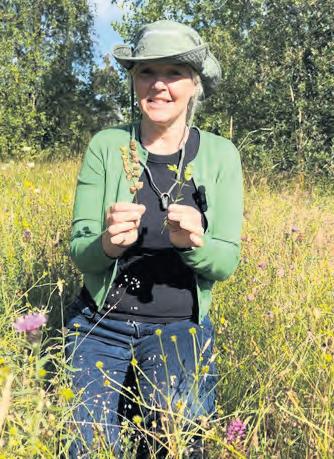


Weather historian Andrew Lancaster delves into the folklore of October weather, its harvests, mists and shortening days
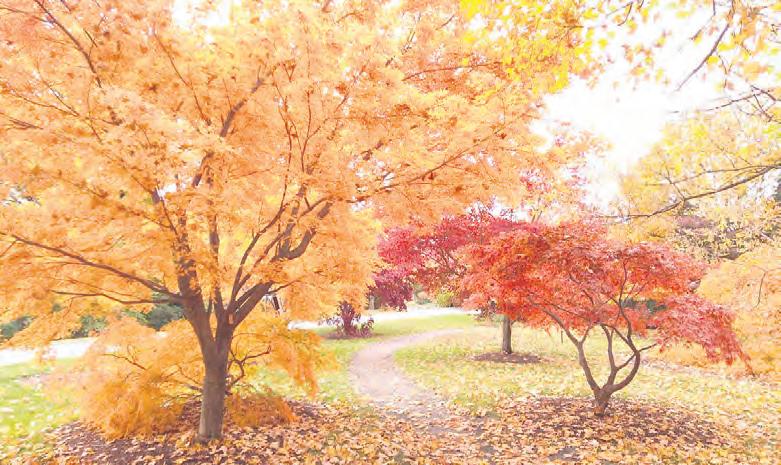
My father was a great quoter of lines of poetry which fitted any time of year. He liked to quote John Clare’s poem –‘The Shepherd’s Calendar” which is all about October.
Nature now spreads around, in dreary hue, A pall to cover all that summer know Yet in the poet’s solitary way, Some pleasing objects for his praise delay
So, while we can be sad at the ending of the summer, we must also look around for delights which are still around us to be discovered. Bright berries, late flowering perennials, the wonderful colouring of foliage, the conkers which we have all had fun with.
And after all, without autumn where would be the freshness of spring?
I get quite emotional about October, and it is a time to keep one’s spirit’s up. Almost everything is giving up, triggered by the light, which fades and shortens every day. Autumn pulls the garden down into itself.
In the flower border the time of seeds has arrived. Flowers are turning into their skeleton. There are still flowers to enjoy. Chief of all is the beautiful funeral flowerthe chrysanthemum.
But the great thing about October and the depths of autumn is that it remains a wonderful reminder about the temperate climate we live in and should enjoy as opposed to the sameness of the tropics and other parts of the world which only have sameness day in and day out. It is the seasons which give us an ever-changing scene. Leaves are shed and we work hard, or should do to sweep them up and compost them ready to return to the soil.
If there is a period of warm weather towards the end of October it is known as St Luke’s Little summer. It is so named because it is said to start on St Luke’s Day- October 18th and be brought to an abrupt end by St Simon and St Jude who share the 28th of the month as their feast day.
Simon and Jude also pop up as summer busters in a rhyme about Michaelmas dasies which are always in flower on Michaelmas Day September 29th.
The Michaelmas daisies, among dead weeds, bloom for St Michael’s valorous deeds And seems the last of flowers that stood, till the feast of St Simon and St Jude.
Old Michaelmas Day falls on October 10th, a result perhaps of the calendar reform of 1752 when 11 days were lost. This is §the day on which Michael threw the Devil out of heaven. He landed on a blackberry bush and cursed it or spit on it or worse. It is a good day to pick and eat blackberries after this date.

21ST OCTOBER - APPLE DAY - the time to celebrate all things apple in all its wonderful varieties. It is also a good day to be planting a new apple tree.
26TH/27TH OCTOBER
British Summer Time comes to an end and the clocks go back in the early hours of the morning. The good news is you get an extra hour in bed and the mornings are lighter for a while. The bad news is it gets darker earlier
31ST OCTOBER HALLLOWE’EN - the perfect opportunity to make the most of at least some of the pumpkins you have grown and turn them into weird and spectacular lantern shapes.
Invaluable for their late-season flowers, asters or Michaelmas daisies fill the autumn garden with colour and wildlife and no garden should be without them for this reason alone.
They produce clouds of colourful daisies during the autumn months, whilst most of the garden is browning into hibernation, asters are stalwart perennials. The most dazzling of the vast range available are the lilac and blue forms, which glow incredible hues beneath the grey skies and sit so well with autumn’s golden grasses.
The soft-pink forms are also beautiful, providing warmth when the weather cools and the perfect foil for falling copper leaves.

The name ‘aster’ is the Ancient Greek word for star and given because the radiate petals of the flowers give them a starry look. In mythology, they grew when Asteria, the Greek goddess of the stars and the mother of Hecate, wept tears of stars from the night sky. In the old world, the plants were ceremonially burnt at the end of autumn, as the smoke was believed to cast out evil spirits and flush out snakes.
Within the 600 or so species and umpteen hybrids of aster, there are also darker shades of pink and purple, as well as white forms, and the plants produce a great range of structure: including upright, bushy, dense, and airy options; some tall and some short. They bloom over a long period, sometimes from August into November, providing hoverflies, bees, and butterflies with vital nectar before winter sets in. Most grow between 60cms and one metre in height. The only drawback is they need to be divided and replanted every three years. If you don’t then they can spread quite dramatically and die out in patches.

Autumn and October is often a time of outstanding beauty. We’re treated to a final burst of colour before the onset of winter. And some years, that colour is more spectacular than ever.
Leaf colour comes from pigments. These are natural substances produced by leaf cells to help them obtain food. The three pigments that colour leaves are chlorophyll (green), carotenes (yellow) and anthocyanins (reds and pinks).
Why is autumn colour better some years?
The depth of colour is influenced by the blend of chemical processes and weather conditions.
• COLD NIGHTS: low temperatures destroy chlorophyll so the green leaf fades to yellow, but if temperatures stay above freezing, anthocyanin production is enhanced and the leaves take on a red colour.
• DRY WEATHER: sugars become concentrated in the leaves, more anthocyanin is produced and consequently leaves are redder.
• BRIGHT SUNNY DAYS: although the production of new chlorophyll stops in autumn, photosynthesis can still occur on sunny autumn days, using the remaining chlorophyll. Sugar concentration increases, more anthocyanin is produced and the leaves are redder.


During October the days are rapidly getting shorter and the sun is becoming lower in the sky. The autumn equinox, when day and night are of equal length has already passed on 23 September. There are often spectacular sunsets, the stars can seem brighter at night, and on some mornings mist hangs over fields and parks. This is a time of nature’s plenty, with a hedgerow harvest of blackberries, rose hips, crab apples, hazelnuts and seeds. Many of much-loved creatures take advantage of this wild harvest to build up reserves of fat for migration or for hibernation.
Anyone wanting to hear a tawny owl – or perhaps glimpse its shadowy form silhouetted against the last scrap of daylight – should go for a stroll on a pleasant autumn evening.
October and November is when these ethereal birds really make their presence felt. They’re our most abundant owls, found even in suburbia and city park. October’s inexorably shortening day length – biologists call it the photoperiod – is what triggers the red deer rut. Pumped with testosterone, mature stags strike out in search of groups of receptive hinds. At dawn and dusk, they bellow and grunt to stake their claim. Though the rut is mostly bluster, battles between well-matched stags can be bloody.
October sees wildfowl begin arriving from the north and east, swelling the flocks of resident ducks, geese and swans. They include pintails, which mostly come from western Russia. Some of our best-looking ducks, male pintails have a long neck and a pair of extremely long central tail feathers, which give them a uniquely rakish profile. Sloes are the fruit of the blackthorn, one of the commonest and most widespread hedging trees on account of its dense growth. October is traditionally when they are finally ripe enough for us to pick.
They look like small, dark plums, with an attractive bluish-purple sheen – but don’t try one straight off the tree. Its intense, eye-watering tartness will almost certainly make you splutter and spit it out. Even birds normally leave sloes untouched, much preferring hawthorn, holly and mountain ash berries. Three species that will eat them are mistle thrushes, fieldfares (winter visitors from the far north) and hawfinches. Heavily sweetened, of course, sloes go famously well with gin, and are excellent too in whisky, port and grown-up chocolate. Unfortunately, excessive and frequent flailing of hedges can lead to a much reduced crop, or even no sloes at all.
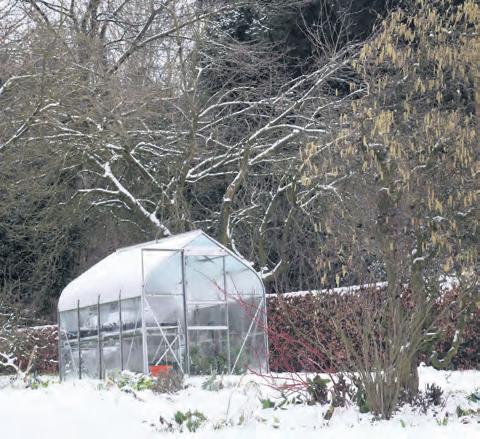
Many gardeners are reluctant to incur the cost of keeping their winter greenhouse at a temperature which will continue to provide warmth to extend the growing season - yet there are ways to insulate the greenhouse better.
Ideally a greenhouse-or the soil in a greenhouse, should be a minimum of 37°F to support a garden.
While it’s more difficult to reach this temperature during the coldest months of the year, it’s not impossible so insulating your greenhouse and installing a heater are not the only heating methods available to you if you want to extend the growing season through the darker and bleaker months.
The high cost of fuel and the desire to garden sustainably are concentrating the attention of more gardeners to operate greenhouses with the minimum energy usage.
The main loss of heat from greenhouses is from draughts and through the structure. The following tips should help improve the efficiency of the heating you choose and save money in the process.
• Seal cracks, replace broken panes and ensure vents and doors fit snugly.
• Add a layer of bubble polythene to insulate the greenhouse. Unfortunately, every layer of plastic cuts out a significant amount of light (about ten percent). This will impact on growth. This also applies to double-glazing, which reduces light transmission.
• Transparent mastic can seal quickly and easily, but use a flexible material otherwise panes can break when the structure flexes in the wind.
• Additional internal protection from frost is possible by draping transparent fleece and other floating films, known collectively as crop covers, laid over or around plants hastening their growth, and protecting against weather and pests. They are usually used without supporting hoops.
• Use fleece over plants in cold snaps. However, covering the whole greenhouse at night with roll-down blinds or by using thermal screens suspended above head height is much more effective (but there is the drawback that they must be deployed each evening and rolled back in the morning).
• Choosing the right temperature can help save fuel. A minimum of 3°C (37°F) is sufficient to sustain many tender plants but it is a bit risky if they get damp, and most greenhouses have cold corners.

• The lowest practical temperature is 7°C (45°F), and 10°C (50°F) will give greater peace of mind. However, alert gardeners can use fleece and other means to protect plants at these fuel-saving temperatures.
A night minimum of 4°C or 5°C is a safe temperature to maintain if you want to be safely buffered against severe snap frosts. If you want to run your heating on a tight budget, have horticultural fleece available to spread over vulnerable plants during excessively cold spells.
There are other options of course to heat the greenhouse in winter - electricity, a paraffin heaters but this can get expensive. One of the most economical heating systems is simply to warm soil, either in a bed, or propagation bench. Soil-warming cable provides heat where it is most needed, at the roots, so even if top-growth is cold-damaged, the roots will survive. Cable is safe and easy to install and, with a thermostat, lets you control soil temperature more accurately. Its performance depends on the cable type, prevailing temperatures and how the system is installed, e.g. a six metre cable consumes 75 watts and correctly installed will sustain temperatures between 15°C and 25°C per square metre of covered bench.

Visitors Welcome Mon - Fri 9.00am - 4.00pm all year round Sat 10.00am - 4.00pm Apr - May
Koirin, Crossroads Nursery, Woodlands, Wimborne, Verwood Road, Dorset BH21 8LN (Near Verwood) Mail order available Tel: 01202 824629 enquiries@azaleacentre.co.uk www.azaleacentre.co.uk

A FAMILY RUN NURSERY FOR THE EXPERIENCED AND NOVICE GARDENER
Large Selection of Perennials (Cottage Garden Plants),Trees, Shrubs, Herbs, Alpines and Vegetable Plants. Plus large selection of Ornamental Trees, Fruit Trees and Climbers.
Good range of OUTDOOR POTS - all frost proof

DELIVERED ALL AREAS
DUMPY BAGS AVAILABLE
MUSHROOM COMPOST
10 40L sacks only £30.50 a load £54 LARGER QUANTITIES CHEAPER
MULTIPURPOSE COMPOST
60L - 6 for £42, £7.25 per bag
HORSE MANURE, BARK, MULCHES, SHINGLES, TURF
JACKS MAGIC 5 ONLY £40
LARGE RANGE AVAILABLE LOGS AND SMOKELESS FUEL
GARDEN & LOG SUPPLIES 01202 740795
www.mayfieldgardenandlogsupplies.co.uk


Reach a passionate and affluent audience of gardening enthusiasts
Over 100,000 copies distributed every month
If you would like to advertise your business or service in our Dorset magazine, please contact corina@countrygardener.co.uk Tel: 01823 410098
GREAT OFFERS ON COMPOST (all compost we supply we use ourselves, so we can recommend it)
Now taking orders for young dahlia plants for spring 2025 delivery





Burley Rd, Bransgore, Nr Christchurch BH23 8DB Tel: 01425 672348 www.macpennys.co.uk
Large traditional family-run nursery
Wide selection of trees, shrubs, perennials & fruit bushes 4-acre woodland garden & Tea Rooms Many unusual plants
MACPENNY’S NURSERIES BRANSGORE
Open Mon - Sat 9am - 5pm Sun & Bank Holidays 10am - 5pm
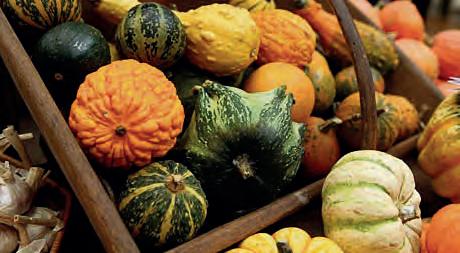



Your garden has worked hard for you this year so treat it to a splash of colour and a nutrient boost for


Scan the QR code to shop online



www.stewarts.co.uk
StewartsGardenCentres StewartsGardenCentres
The garden isn’t always a place where everything grows and flourishes. They are always casualties but the cause of death for trees, shrubs and plants may be down to a few very manageable and avoidable reasons.

Although many plants will happily live and thrive for a long time, they are not immortal.
Their lives can be prolonged by proper care and attention, but plants can die, and they can die for a wide range of, and sometimes baffling, reasons.
But for the most part the cause of death can be very easily traced.
Plants, unlike animals, can’t up their roots and move to a more protected place when unfavourable weather patterns dictate. They can’t hibernate or go inside when it’s cold unless you grow them in pots and physically move them inside.
They just must sit and bear it.
And, when they’re stressed they are more prone to pests, diseases and physiological disorders – or problems caused by the local conditions, normally soil, aspect and climate or weather.
It may not be complete but there is a hit list of what might be wrong:
Watering: Too little water can cause plants to wilt and stunt their growth, while too much water can suffocate the roots and lead to root rot.
Soil: The wrong type of soil can prevent plants from getting the nutrients, water, and sunlight they need.
Light: Too little light can cause plants to lose colour, become leggy, or stop growing, while too much direct sunlight can scorch or wilt leaves.
Fertiliser: Overdosing a plant with fertiliser or compost can kill it, especially for younger plants.
Disease or pests: Disease is a major cause of plant death.
Environment: Plants can die from drought, heat, cold, or fires.
Before you plant anything, get to know your garden’s water environment. Is it humid? How much rain do you get? Does it get really hot so all the water evaporates? Do you have soil that holds water? Or soil that lets the water drain quickly away? Is it a place that gets winter water that melts in the spring, but then is bone dry by mid-summer? What is the water from your hose like?
Be realistic when you water plants. Make sure your plants can handle it when you forget, don’t feel like it, or when life generally gets in the way. Garden plants die when you forget. Have a Plan B. Plan B should be one of two things – plant only plants that can live with only the amount of water that naturally comes to your garden (preferable) or install an irrigation system.
Add organic material (compost) to your soil. Among many other good things, it helps retain water. Mulch the top of your soil so less water escapes. Mulching is like adding a crust that keeps the moisture trapped. Use compost for this as well. Plus when water percolates through the compost, the roots get extra nutrients. And understand that the guidance and research about the needs of your plants usually assumes that the plant
has established its root system and should thrive. Newly planted perennial plants, shrubs and trees aren’t going to be fully ‘established’. until they have lived at least a couple years in the spot where you have asked it to grow. In the meantime, they will all need more ‘TLC’ and water than the plant guides call for.
The slightest puff of wind will send your ‘prize specimens’ heading for the floor!
But the soil can be too rich as well.
This is because of the way plants ‘think’ and they’re a bit like us in this respect.
If we constantly eat too much, we become fat, less fit and a little more lethargic. It’s the same with plants.
The plant becomes ‘fat and lazy’ which in plant terms means it produces lots of sappy green growth which is wobbly and floppy.
If the plant is in a less rich soil, it starts behaving as though it will probably die.
This causes it to think, ‘ooh must reproduce myself quickly before I conk out’. So it starts to flower copiously in order for it to produce seeds, so there is less energy to devote to growing all those succulent green leaves.
So, an over rich soil for plants that don’t need much food produces floppy plants too.
You must test your soil

Your plants will grow well if they have food and water, so the soil really determines how well everything will grow or struggle to get established.
It almost goes without saying that you must get to know as much about the soil in your garden as you can. Do a PH test. Without that you will never be able to guarantee you are planting the right plant in the right soil.
A poor soil that lacks nutrition will produce weak straggly plants that flop easily or droop everywhere.
An endless supply of little bugs wants to live in and eat your plants. They’ll munch on the leaves until nothing green remains or create a home in the plant and slowly eat its nutrients until the leaves start to fall off and die.
Quarantine any plant on which you find bugs, to help prevent the bugs from spreading.
Keep an eye out for unwanted visitors, and for holes in the leaves of the plants – that’s a sure sign that hungry insects are present.
Plants grow toward the sunlight.
If light levels are low, the plant tries to grow fast to get to as much light as possible quickly, it becomes a leggy skinny teenager of a plant.
Once it has reached the light, it isn’t strong enough to support itself properly, so the plant will flop over.
If light levels are low, then look to create light to allow more sunlight down onto the soil. You can also thin out the branches to let more light through.
The plants will grow stronger from the bottom up. So, they won’t flop over as easily.
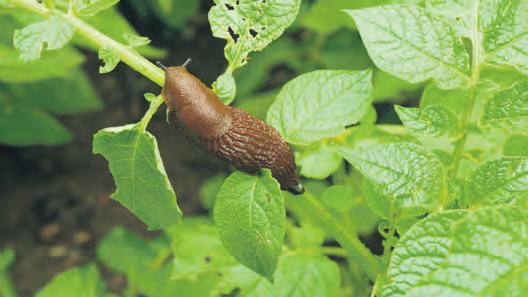
Don’t let pests take advantage of all your hard work and make a feast out of your garden, protect your plants instead by employing the services of a good insect spray.
How to tell a good insect spray from a bad one?
Different ingredients will get rid of different pests, so make sure that the insect spray you chose has active ingredients that are meant for combating the pests your plant actually has. And checking what other people are saying about the product can also give you a good indication of a spray’s effectiveness.
There are many pests and diseases that attack plants and some can lead to plant death. Root rot for example, which can be caused by a soil-borne pathogen such as a fungus or may occur in poorly drained soil, can cause a plant to die very quickly. It won’t always be possible to cure root rot, but here’s how to try: Take the plant out of its pot and remove any excess soil.
Once you’ve removed as much soil as possible, rinse the roots under lukewarm water.
Using clean secateurs cut back and get rid of any rotten/dead/damaged roots. Treating root rot involves removing any rotting roots or foliage and repotting the plant in fresh soil to give the remaining healthy roots a new start.
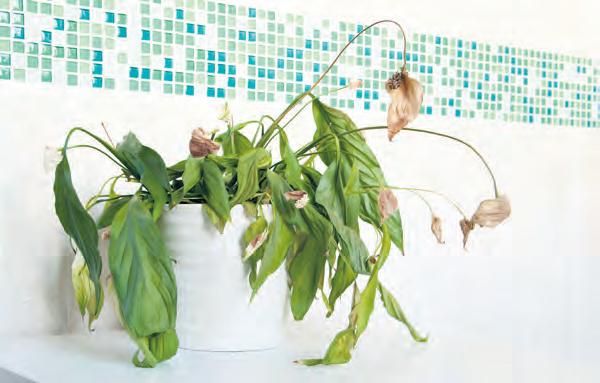
The best way to avoid having to bring back a dying plant is to keep a close eye on it and to act quickly whenever you see a leaf starting to look a little weird, or you see any visual changes. The best tools to keep an eye on your plant are your eyes and hands.
Remove the plant you are concerned about from direct sunshine and wait until the soil dries out before watering again. If the soil is wet, you should replace both the soil and the pot. After that, carry out some research. Look up your plant’s watering requirements and make sure you follow them in the future. Take out all dead or dying leaves or branches. Consider adopting a feeding schedule during the growing season. While most plants can survive without feedings, they may withstand inhospitable growing conditions more easily when you feed them. For example, if your plant likes a lot of sunlight and you don’t have a sunny window, you might keep it as happy as possible in low-light conditions with regular feeding. And then be patient – give the plant time to recover. It’s a bit like a human recovering from an operation. No-one expects the patient to be up and about dancing after a couple of days – that might take weeks.
A living / dying plant checklistthe possible reasons

1. The plant was sick when you planted it.
2. You’ve planted it in totally the wrong area for it to thrive.
3. You’ve planted in the wrong soil plants can be quite particular.
4. You’ve forgotten to water it!
5. It’s drowned from too much watering.
6. Waterlogged soil kills most non-aquatic plants.
7. The ground is so dry the plant just dies.
8. Roots were left exposed when it was planted.
9. It is diseased or is being eaten.
10. The weather (frost and cold) has killed it.
11. Too much sun has caused it to shrivel and die.
Diary events from clubs and organisations in

Take advantage of our free service giving publicity and promotion to gardening club events. We are happy to carry details of events, meetings and trips. End your information to timeoff@ countrygardener.co.uk
Warsash Horticultural Society HISTORY OF FURZEY GARDENS’GRAHAM WATERS www.warsashhorticulturalsociety. chessck.co.uk
Details on 01489 573755
Verwood & District Horticultural Society ‘BULBS FOR SPRING, SUMMER AND AUTUMN’ - TIM WOODLAND Details on 07508 571714 4TH
Shaston Gardening Association MONTHLY MEETING www.shastongardeningassociation. weebly.com
7TH
Highcliffe Horticultural Society ‘HOLME - THE MAKING OF A NEW PUBLIC GARDEN’ - SIMON GOLDSACK Details on 07769 748187
West Moors Horticultural Society ‘THE RHS’ - DAVID MOON Details on 01202 871536
Wimborne Gardening Club MONTHLY MEETING Details on 01202 888703
Ferndown & District Horticultural Association HORTICULTURAL THERAPY AT HIGH MEAD FARM’ - RACHEL COLLEY Details on 07790089889 8TH
The Southill Gardening Club ‘OVER WINTERING FUCHSIAS’DEREK DEXTER Details on 01305 788939 9TH
Petersfield Gardeners’ Club MONTHLY MEETING
Totton & District Gardeners Society ‘FERNS & GRASSES’ - CHRIS BIRD Email: Totton.gardeners@btinternet. coom
11TH
Blackmore Vale Bonsai Group MONTHLY MEETING Details on 07837 781744
Uplyme & Lyme Regis Horticultural Society AUTUMN SHOW AND COFFEE MORNING www.ulrhs.wordpress.com 15TH
Parkstone Gardeners Club ‘RESCUING HEDGEHOGS’ - CARLA ENGLAND 16TH
Milford Gardeners’ Club ‘WILDLIFE IN A VILLAGE’ - MIKE READ www.milfordgardenersclub.co.uk 17TH
Corfe Mullen Gardening Club ‘CLAY, CORDITE, SANDFORD & HOLTON HEALTH’ - BEN BUXTON Details on 01202 692526
Sway Gardening Club ‘IN AT THE DEEP END - DESIGNING MY FIRST GARDEN’ - EMMA O’GRADY www.swaygardeningclub.co.uk 20TH
The Valley Gardening Club AGM Email: valleygardening@gmail.com 23RD
Uplyme & Lyme Regis Horticultural Society ‘UNEXPECTED FRUITS’ - MARK DIACONO www.ulrhs.wordpress.com
30TH
Warsash Horticultural Society ‘MOTTISFONT’S ROSE GARDEN PARADISE’ - MICHAEL HARVEY Details on 01489 573755
Are you part of a garden club or society?
Are you part of a garden club or society?
Are you part of a garden club or society?
Please send us your diary for the year - we’d love to include your talks and shows It's free!
Please send us your diary for the year - we’d love to include your talks and shows It's free!
Please send us your diary for the year - we’d love to include your talks and shows It's free!
Send them into us by email giving us 10 weeks notice of the event: timeoff@countrygardener.co.uk or by post to: Mount House, Halse, Taunton, TA4 3AD.
Send them into us by email giving us 10 weeks notice of the event: timeoff@countrygardener.co.uk or by post to: Mount House, Halse, Taunton, TA4 3AD.
Send them into us by email giving us 10 weeks notice of the event: timeoff@countrygardener.co.uk or by post to: Mount House, Halse, Taunton, TA4 3AD.
ACCOMMODATION
Secluded cosy cabins & lodges in wooded valley running down to Wembury Bay & SW Coastal Path

Plymouth, Dartmoor & lovely South Devon Villages & Towns in easy reach. Pets Welcome. Forest School. Tel: 01752 862382 www.churchwoodvalley.com

Carmarthen Bay South Wales
Seafront chalet situated on estuary. Sleeps up to 6. Seaview. Well Behaved Dogs Welcome Free of Charge. Free WIFI. Open from 1st March - 31st Dec. For Brochure
BOSWORLAS, ST JUST.
Cosy Cottage sleeps 2-4. Please email info@bosworlas.co.uk for availability
GLORIOUS NORTH DEVON. Only 9 cosy caravans on peaceful farm. Wonderful walks in woods & meadows. Easy reach sea, moors & lovely days out. £125-395pw. Discount couples. Nice pets welcome. 01769 540366 www.snapdown.co.uk
ACCOMMODATION HOLIDAY COTTAGES
WYE VALLEY/FOREST OF DEAN. Fully equipped single-storey cottage with two en-suite bedrooms. Wi-fi. Recently awarded Visit England 4-star GOLD. Rural retreat, shops/pubs one mile. Enquiries welcome. AS SEEN ON ESCAPE TO THE COUNTRY! Tel: 01594 833259 www.cowshedcottage.co.uk

NORTH DEVON NEAR CLOVELLY. 3
delightful cottages situated in 12 acres of idyllic countryside. Sleeps 2-4. 1 Wheelchair friendly. Brochure: 01237 431324 www.foxwoodlodge.co.uk foxwoodlodge@outlook.com
CARDS & GIFTS

A range of over 200 greetings cards and prints from the flower paintings of ANNE COTTERILL
We sell to both individuals and trade. No order too small. Contact us for your free catalogue.
Mill House Fine Art Publishing, Bellflower Gallery, Market Place, Colyton, Devon EX24 6JS Tel. 01297 553100 info@millhousefineart.com www.millhousefineart.com

Tel: 01291 641826



jonne@jonne.co.uk 07770 720 373




Tel: 01269 862191 Near Stratford-upon-Avon
Email: lynne@bryncosyn.co.uk www.bryncosyn.co.uk

Lovely self-catering cottage in peaceful location: large garden. Sleeps 2. Perfect for famous gardens, NT properties & Cotswolds. Tel: 01789 740360 www.romanacres.com


Artist blacksmith based near Axminster designing and manufacturing garden plant supports, structures, garden art and fine art bronzes. Commissions welcomed. www.thegardenersblacksmith.co.uk




01792 391212 www.penricecastle.co.uk

Sowing in October will give these wonderful, scented flowers an extra six months of plant growth
Hardy annuals like sweet peas will grow, flower and die all within 12 months.
By sowing in the autumn instead of spring you give the plant six months of extra growth. So, by next summer they can sustain bigger, earlier flowers on stronger stems.
You also have two seasons to sow, to guarantee success and a longer flowering season. Flowering dates vary from year to year so a succession of sweet peas is particularly important to be able to get these beautiful scented flowers to be at their best.

Sweet peas can be started off in October in all of the southern half of the UK, for example. If it’s cold where you grow - wait until spring. While autumn sowing gives a head start and hence early flowering, springsown sweet peas will still yield fistfuls of blooming stems by summer.
Sowing itself is straightforward.
Sow into pots of quality compost, setting one seed to each 7cm (3in) pot or several seeds into a 15cm (6in) pot. Seeds sown in autumn need to be kept protected, so place the pots into a cold frame or greenhouse. Cover the pots with newspaper until the seedlings emerge.
Seeds sown in late winter will likely need a little additional heat to help them pop up. Once they have germinated, remove the heat source to encourage the plants to grow stout and sturdy rather than tall and leggy.
Spring-sown sweet peas can be started off in pots if the soil isn’t quite ready, or directly sown where they are to grow, as soon as conditions allow. Avoid cold, wet soil at all cost – you don’t want your seeds to rot.
Some gardeners recommend soaking the seeds overnight in order to speed up germination. Others suggest nicking the hard seed coat with sandpaper to help moisture penetrate. It has been found sweet peas germinate just fine without this intervention, but if you have difficulties you could try either method.
Autumn-sown sweet peas should be kept in their cold frame or greenhouse to overwinter. While you don’t want to mollycoddle seedlings too much (cool temperatures will keep plants stocky and sturdy) they won’t appreciate being repeatedly frozen, so add extra protection in frosty weather. Cold frames can have layers of sacking/burlap or bubble wrap laid over the top, for example.
Encourage plants to bush out by nipping out the top two leaves as soon as plants have grown four leaves. This stimulates new side shoots, which means more stems and, ultimately, more flowers! Watch out for the usual suspects: slugs, snails and mice have a penchant for foliage and seeds respectively.
You can plant out your pot-raised sweet peas as soon as the weather has warmed up and soil conditions allow. Pick a sunny site and plant into moist, rich soil. Plant the seedlings 20-30cm apart against supports such as pea netting, or trellis. The best effect, however, comes from growing up rustic wigwams – the sort made from hazel poles tied at the top with string. Initially you may need to encourage sweet peas up their supports by tying them in with string. Once they have found their feet they will pull themselves up with their twining tendrils. The golden rule with sweet peas, like many prolific flowerers, is to keep on picking! Snip off faded blooms and remove any seedpods you find and your sweet peas will continue to produce a steady stream of flowers for cutting to enjoy at home or give away – sweet rewards indeed for your diligence.



• All year round barbeques and parties
• Children can play outdoors come rain or shine
• Cats and Dogs love the cover
• Patio tables and chairs stay dry - No need to store away for most of the year
• Any colour and any size to suit you and your property
• Supply and install or Supply only
• D.I.Y kits available - Trade Discounts









Mark Hinsley delves into the science, history and sheer beauty of autumn leaves and trees.
What is the science behind autumn colour?
The colour of leaves is caused by pigments in the leaf structure, which are there to aid photosynthesis and perform other functions. The dominant pigment through most of the year is chlorophyll, which is green.
However, there are two other groups present, carotenoids, which are orange and yellow, and anthocyanins, which are pink, red and purple.
In autumn, trees that lose their leaves for winter go through a process to shut down photosynthesis and reclaim as many valuable chemicals as possible. Through the summer the green chlorophyll is constantly breaking down and being replaced. As the day length shortens and temperatures drop, this process of renewal slows down and stops. This reveals the other colours in the leaves which have been hidden by the green chlorophyll. The precise mixture of carotenoids and anthocyanins varies between species, so the degree of yellow or red colour in the leaves varies accordingly.
A warm dry ‘Indian summer’ followed by a spell of frosty nights is the best combination to produce a short but spectacular blaze of Autumn colours. In mild wet Autumns the processes are slower and leaf drop is drawn out, some leaves having deteriorated to completely brown before they fall.
Autumn colour in landscape design
The classic combination in large landscape design is autumn colour and a large body of still water.
Capability Brown was at it all over the place, Sheffield Park in Sussex being a prime example. However, in my humble opinion, the best of the best is Stourhead in Wiltshire. If ever a place was heaven on earth…….
Originally laid out in 1740 by Henry Hoare, Stourhead is worthy of a visit all year round, but in autumn it simply goes off the scale. The bulk of the autumn colour is provided by native Beech woodland on the hillsides surrounding the lake. However, closer to the water exotic species are added to the pallet. Most famous among them are the tulip trees. Imported to England from the east coast of America in the 1600s, these trees were available to Henry VIII for his planting. Their butter yellow autumn leaves reflected in the still water of the lake on a clear, sunny day are stunning.
Editorial Publisher & Editor: Alan Lewis alan@countrygardener.co.uk Tel: 01823 431767
Swamp cypress, another early introduction from the east coast of America, adds its more terracotta colouring to the scene.
One of my favourites is a variety of a British native tree, the cut leaf beech. There is a group of them near the grotto. Stand under them and look up to catch the light filtering through their fillagree foliage in green or autumn yellow.
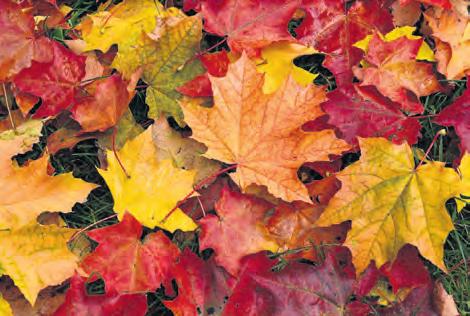
Henry Hoare’s successors have not stood still. Not autumn colour subjects, but the ubiquitous giant redwoods, coastal redwoods and western red cedars are there as they are in any large garden that existed during Victorian times. Japanese maples and katsuras bring strong reds and pinks. A word of warning, if you take the grandchildren and they kick through the fallen leaves of a katsura, they will be treated to a strong smell of candyfloss.
Beware, because they will want some! Autumn colour in your garden
Stourhead benefits from being in a sheltered valley. If you plant autumn colour in a windy location, you will not have it for long. Suitable subjects come in a range of sizes from dwarf Japanese maples, low spreading parrotias, small snowy mespilus, medium sized liquidambars and potentially very big tulip trees. If you prefer your trees native, hawthorns, hazels, rowans, field maples and beech will not let you down.
Time Off Kate Lewis timeoff@countrygardener.co.uk Advertising Sales Ava Bench - Somerset & Hampshire ava@countrygardener.co.uk Tel: 01278 786139 Cath Pettyfer - Devon cath.pettyfer@countrygardener.co.uk Tel: 01837 82660
Corina Reay - Cotswolds & Dorset corina@countrygardener.co.uk Tel: 01823 410098
Classifieds classified@countrygardener.co.uk
Accounts and subscriptions Heather Rose heather@countrygardener.co.uk
Design & Production
Aidan Gill aidan@countrygardener.co.uk
Gemma Stringer gemma@countrygardener.co.uk
Distribution & Stockists distribution@countrygardener.co.uk

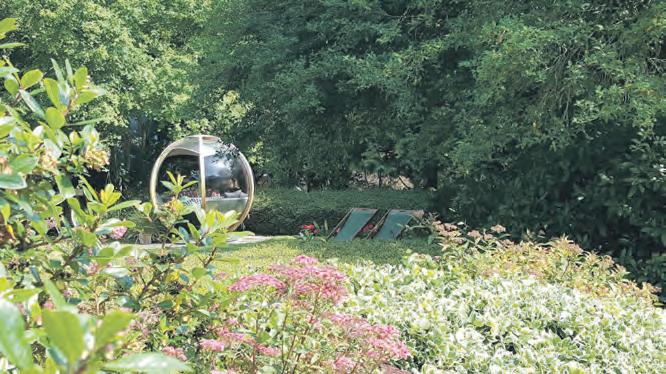






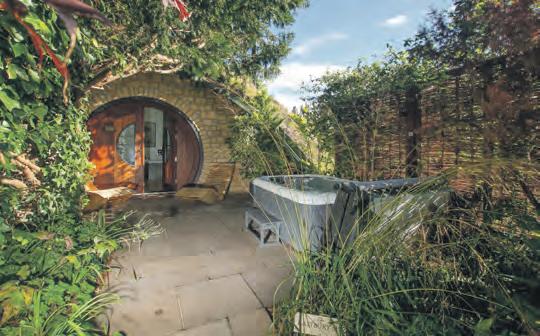
OUR GARDEN ESCAPE AT THE EASTBURY HOTEL & SPA IN SHERBORNE, DORSET
Our jewel in the crown, our beautiful award winning walled garden offers a sanctuary of calm and tranquillity, perfect for those looking to get back to nature and relax.
Our Garden Escape Stay includes a two-night stay in one of our Garden Deluxe Rooms with wholesome Dorset breakfast served to you each morning, Indulgent Afternoon Tea for two, entry to Minterne Gardens on one day
From £136.00 per person per night
Why not book an extra night to include entry to Sherborne Castle Gardens and a country picnic
Quote “Country Gardener” and receive a complimentary bottle of Sherborne Castle Wine and sweet treats on arrival
THE EASTBURY HOTEL & SPA | LONG STREET | SHERBORNE | DORSET | DT9 3BY
